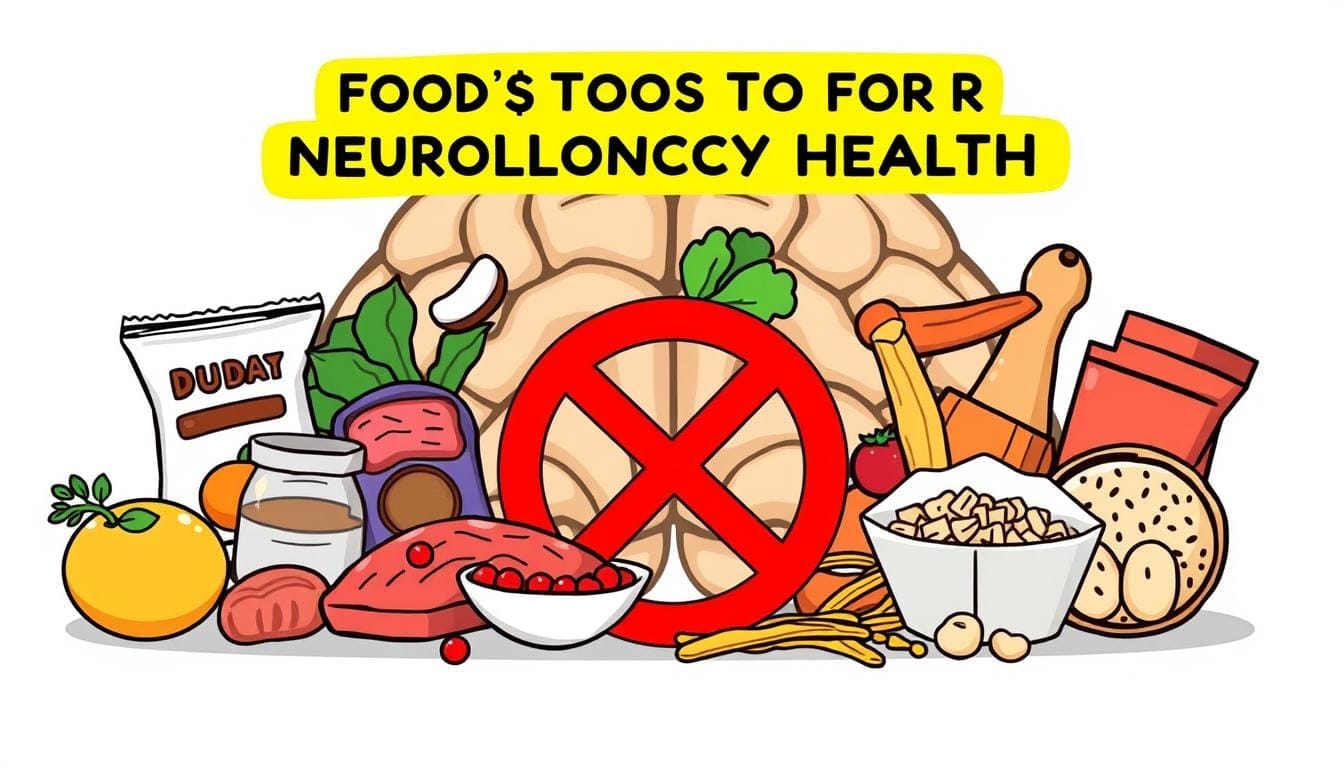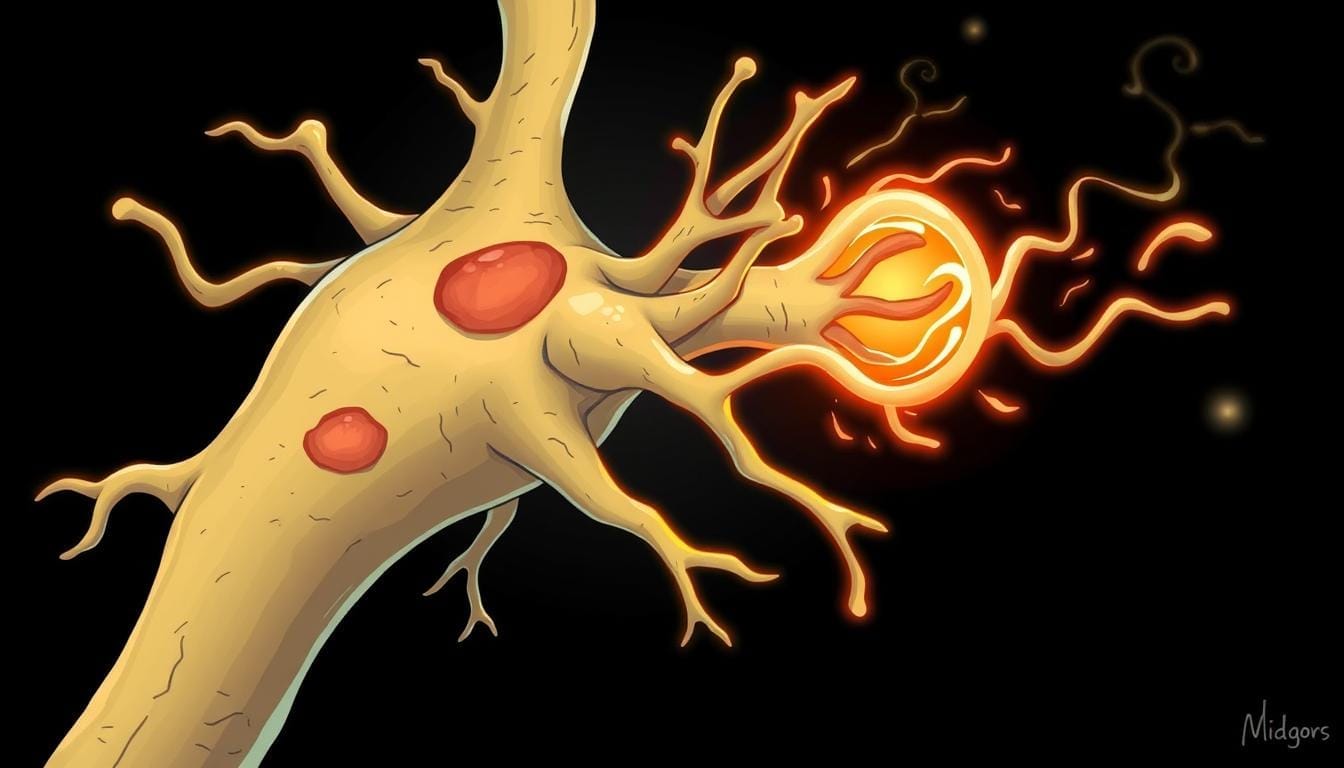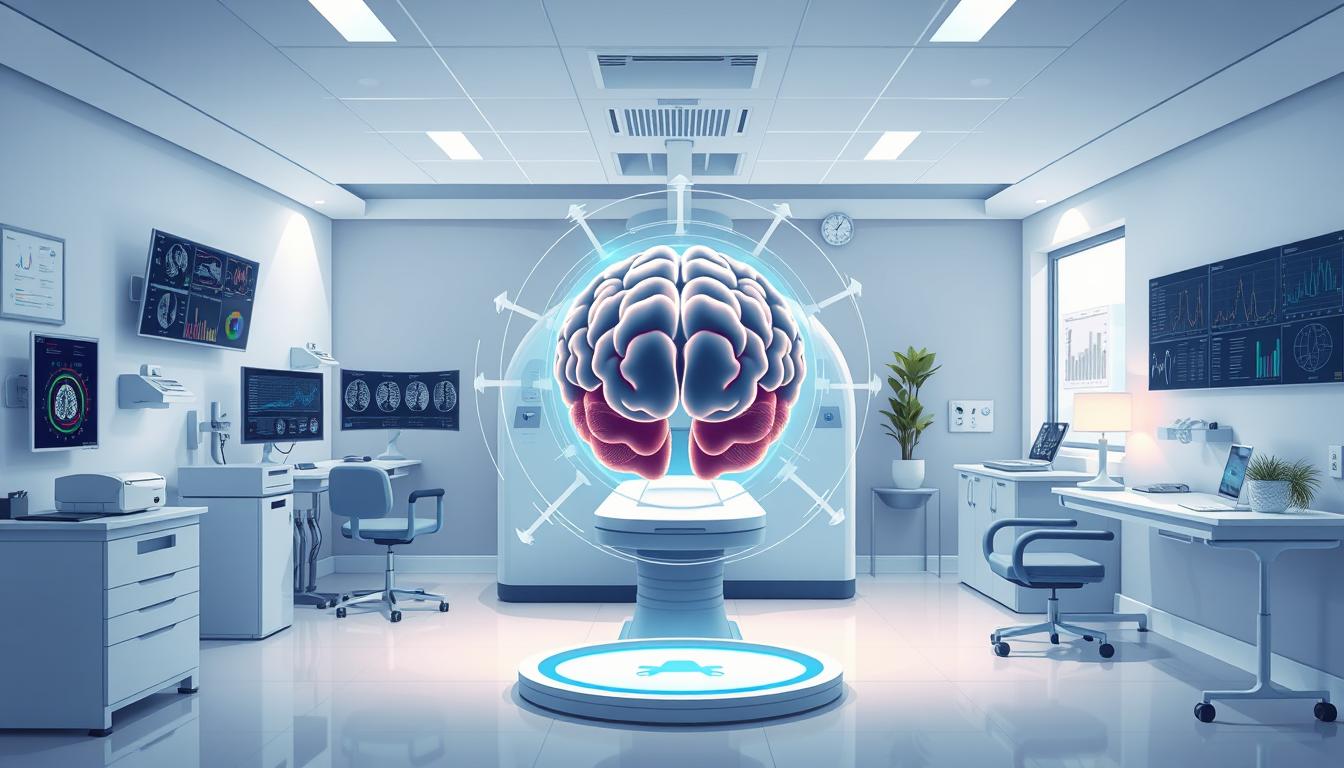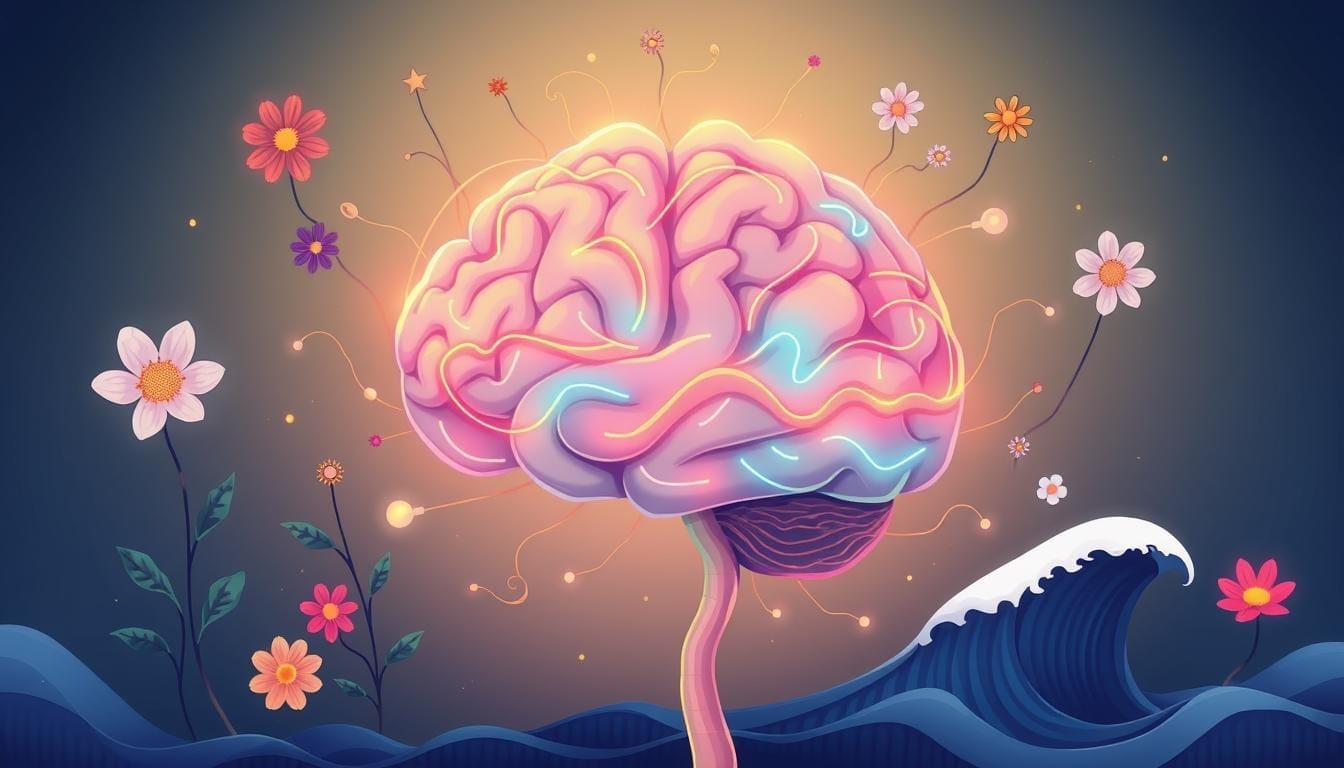The Link Between Diet and Childhood Cognitive Growth
Is your child's food helping their brain grow or slowing it down?
Parents across the world want their kids to succeed, in school, in sports, and in life. But few realize that one of the most important keys to brain development sits right on their plate. Yes, food isn't just fuel; it's brain-building material.
From what your child eats at breakfast to the snacks they munch on after school, every bite matters. The diet and childhood cognitive growth connection isn't just a theory, it's backed by science, stats, and real-life cases.
In this blog, we’ll explore how everyday nutrition shapes thinking skills, memory, behavior, and even IQ levels. Whether you’re a concerned parent, teacher, or health enthusiast, you’ll walk away with easy, evidence-backed ways to support your child’s brain with food.
What is Childhood Cognitive Growth?
Cognitive development in young children is complex and fascinating. It includes skills like attention, memory, and thinking. As their brains grow, these skills get better, helping them succeed in school and life.
Defining Cognitive Growth in Children
Cognitive growth means kids get better at understanding and solving problems. Research shows that how well a child thinks at preschool age can predict their school success. This is because their brain changes a lot in early years.
Importance of Cognitive Development
Cognitive development is very important for kids. As their brain grows, different parts develop at different times. For example, the parts that help with thinking and learning grow a lot in the first two years, then again between 7-9 and around 15.
Studies link early physical growth, like head size, to how well kids think at age 2. Birth weight and how fast kids grow early on also matter for their thinking skills. Knowing how child psychology, parental guidance, brain function, and cognitive skills work together is key to helping kids grow.
As kids play and talk with others, they start to understand the world. They learn to predict and explain things. This early learning is the base for future success in school and life.
Why Does Nutrition Matter for a Child’s Brain Development?
Your child’s brain is like a sponge. It grows fast, so it needs the right building blocks. Those building blocks? Nutrients from food.
Let’s see how brain development works to understand why the diet and childhood cognitive growth link is so powerful.
How Does the Brain Develop in Early Childhood?
Your child’s brain grows the most in the early years. By the time they’re five, most of their brain is already developed.
Quick facts:
- 90% of brain development happens before age 5
- Brain cells connect rapidly in the early years to build memory, attention, and language skills
- The brain uses more than 50% of the body’s energy in the first few years
That’s why giving the brain the right nutrients early on is critical.
What Happens When the Brain Lacks Nutrients?
A poor diet doesn’t just make kids feel tired, it slows down their brain development.
- Children with poor diets show delays in cognitive milestones like speaking, understanding, and problem-solving
- Studies show undernourished kids often have lower IQs and weaker memory
- The effects of poor nutrition on brain development can last into adulthood
A UNICEF report found that over 200 million children globally do not reach their full brain potential because of poor diets.
Case study: In rural India, undernourished children aged 3-6 years scored 30% lower in problem-solving tasks than their well-nourished peers.
Read: Child Health Risks And Health Checkup

Which Nutrients Are Essential for Childhood Cognitive Growth?
Good food is key for kids' brains to grow. Some foods are especially good for brain health and thinking skills.
Omega-3 Fatty Acids
Omega-3s, especially DHA and EPA, make up large parts of the brain.
Simple facts:
- DHA builds brain cell walls
- EPA helps reduce inflammation that may harm brain function
- Kids who eat more omega-3s score better on memory and reading tests
Sources of omega-3 for cognitive development:
- Fatty fish (salmon, sardines)
- Walnuts
- Flaxseeds and chia seeds
Antioxidants
Antioxidants like vitamins C and E protect the brain. They fight off damage that can hurt thinking. Fruits, veggies, and whole grains are full of these brain-protecting nutrients.
Vitamins and Minerals
Important vitamins and minerals are vital for the brain. Iron, zinc, iodine, and vitamin B12 help the brain work right. Iron, zinc, and iodine support brain health, while vitamin B12 helps make important brain chemicals.
Eating these foods helps kids think better and do well in school. Giving kids the right nutrients helps their brains grow strong for learning all their lives.
Breakfast: The Most Important Meal for Kids
Eating a nutritious breakfast is key for kids' brains and school work. Studies link breakfast to better cognitive function. This includes memory and focus. Breakfast gives kids the vitamins and minerals they need for a sharp mind all day.
How Breakfast Affects Concentration
Having breakfast regularly can make a child's diet better. A study in Chile found that kids who skipped breakfast did worse in school. Those who ate well before school did better.
Nutrient-Rich Breakfast Options
- Whole-grain cereals with milk and fruit
- Eggs with whole-wheat toast and avocado
- Oatmeal with nuts, seeds, and berries
- Greek yogurt with granola and fresh fruit
These breakfasts are full of good stuff for kids' brains and school work. A healthy breakfast helps kids do well all day.

The Impact of Sugary Foods on Cognitive Abilities
Too much sugar can hurt a child's brain power. Studies show that too much sugar can make blood sugar levels go up and down fast. This can make it hard to focus and pay attention.
Understanding Sugar's Effect on Brain Function
The brain needs a steady flow of glucose to work well. But eating too much sugar can mess with this. High sugar levels can change the brain and hurt learning and memory, especially in the hippocampus.
Research on rats shows that sugar can hurt memory. Also, eating sugar early in life can harm learning and memory in the brain.
Alternatives to High-Sugar Snacks
- Whole fruits: They are sweet and full of fiber, making them a better choice than sugary snacks.
- Vegetables with hummus: Mixing veggies with protein-rich hummus can curb cravings and boost brain health.
- Nuts and seeds: These snacks are full of nutrients and give energy, helping the brain work better.
Choosing healthier snacks can help kids think better and feel better. Parents and caregivers can make a big difference by picking the right foods.
Read: Lack of Protein in Indian Diet: Causes, Symptoms, and Solutions
The Importance of Hydration for Brain Health
Drinking enough water is key for a healthy brain. Even a little dehydration can hurt how well we think and remember. It's important to drink water all day and eat foods with lots of water too.
Effects of Dehydration on Cognitive Performance
Dehydration can make kids feel tired, sleepy, and grumpy. It can also make it hard to focus. Drinking water helps fix these problems, but it takes time.
Strategies for Keeping Children Hydrated
- Encourage regular water intake throughout the day, aiming for at least 1.2 liters per day.
- Offer water-rich foods like fruits and vegetables, such as watermelon, oranges, and cucumbers.
- Limit sugary beverages and encourage water or milk as the primary drinks.
- Remind children to drink water before and during physical activity or in hot weather to replace fluids lost through sweat.
- Monitor children's hydration status by looking for signs like dark urine, headaches, or fatigue.
Drinking enough water is vital for our brains and mood. By making sure kids drink enough, we help their brains stay healthy and happy.
The Link Between Whole Foods and Academic Success
Whole foods are key for kids' brains and school success. They are not processed much and full of good nutrients. These foods help the brain work its best.
Defining Whole Foods
Whole foods are natural and full of nutrients. They are not changed much from their natural state. This means they have more vitamins, minerals, and healthy fats than processed foods.
Examples of Brain-Boosting Whole Foods
- Berries: Full of antioxidants, berries help with memory and focus.
- Leafy Greens: Foods like spinach and kale are packed with nutrients for the brain.
- Fatty Fish: Fish like salmon are great for brain health because of omega-3s.
- Nuts and Seeds: These foods are full of good fats and vitamins for the brain.
Eating these foods can really help kids do well in school. It's good for their brain and learning.
What Are the Best Brain-Boosting Foods for Kids?
Want to pack your child’s lunch with smart choices? Focus on a mix of protein, good fats, fiber, and key vitamins.
What Should Be in a Cognitive-Friendly Lunchbox?
Here’s a simple table to guide you:
| Food Item | Key Nutrient | Brain Benefit |
|---|---|---|
| Boiled eggs | Choline, protein | Builds memory center in the brain |
| Whole wheat roti | B-vitamins, fiber | Supports nerve function |
| Nuts (almonds) | Vitamin E, omega-3 | Boosts focus and brain protection |
| Yogurt | Probiotics, calcium | Improves mood and reduces anxiety |
| Fruits (berries) | Antioxidants, vitamin C | Improves memory and thinking speed |
Are Plant-Based Diets Effective for Child Brain Growth?
Yes if planned well.
- Vegetarian children can still get enough nutrients for child brain development
- Use foods like tofu, lentils, seeds, whole grains
- Consider B12 supplements if needed
Plant-based diets are safe, but careful planning is needed to protect diet and childhood cognitive growth.
The Role of Family Meals in Brain Development
Mealtime is key for a child's brain growth. It's where they learn to talk and bond with family. Family meals help kids eat well and do better in school. They also learn to behave better.
Benefits of Eating Together
Family meals are great for kids' brains. Parents can teach them about food and healthy eating. This helps kids speak better, solve problems, and feel good emotionally.
How Family Meals Encourage Healthy Eating Habits
- Parents can show kids the right foods to eat.
- Kids try new foods and eat a variety.
- They help make meals, which makes them appreciate food more.
- Meals are a chance for family bonding and learning about food.
Regular family meals help kids grow smart and healthy. This way of eating and learning together is very important. It helps kids do well in school and feel good.

The Influence of Diet on Mental Health in Children
Research shows a strong link between diet and mental health in kids. Studies have found that what kids eat affects their mood, emotions, and brain function.
Connection Between Diet and Mood
A study from Norway involved over 40,000 people. It found that a healthy diet in moms during pregnancy helps kids avoid depression and anxiety at age 8. It also showed that a healthy diet makes kids more outgoing, kind, and creative.
Foods That Support Emotional Well-Being
- Omega-3 fatty acids in oily fish help kids feel better and may prevent mental health issues.
- B vitamins in whole grains, greens, and lean meats are key for kids' emotions and thinking.
- Zinc and magnesium in plants and lean meats boost mood and emotional health in kids.
Experts say a diet full of nutrients is vital for kids' mental health. Parents can help by teaching kids to eat well. This way, kids can stay mentally healthy and emotionally balanced as they grow.
Cultural Dietary Practices and Cognitive Development
Diet and brain growth are linked, not just by nutrients but by cultural food ways. Across the globe, different groups have special food traditions. These traditions nourish the body and help the brain grow in kids.
Exploring Diverse Diets Around the World
Cultures that focus on traditional foods use many nutrients good for the brain. The Mediterranean diet, for example, is full of omega-3s, antioxidants, and fiber. Diets in Asia and Africa also include herbs, fermented foods, and lots of plants, which might help the brain.
Lessons from Traditional Diets
- Traditional diets worldwide help brain growth and prevent malnutrition, which harms brain development.
- These diets often have lots of different foods, which is key for brain health.
- Research shows that cultural foods, like breast milk and animal products, boost kids' brain skills.
- Looking into traditional diets can teach us how to improve nutrition and brain health globally.

Learning about cultural diets and brain growth can help us use traditional foods better. This can support the health and growth of children everywhere.
What Does the Research Say About Diet and Childhood Cognitive Growth?
Let’s explore some trusted studies to understand more.
What Are the Most Recent Studies Showing?
| Study | Population | Key Finding | Source |
| Harvard 2020 | 1,300 kids | Breakfast improved math scores by 25% | Harvard.edu |
| WHO 2021 | 12 countries | Iron deficiency = lower IQ scores | WHO.int |
| NIH 2022 | US Teens | Omega-3 linked to better memory | NIH.gov |
These studies prove that the diet and childhood cognitive growth link is backed by hard science.
Are There Any Contradictory Findings?
Some say genes affect brain growth more than food. But recent research confirms:
- Genes set the stage
- Food builds the brain
So while DNA is a factor, diet plays a huge role, especially in early years.
Fostering Cognitive Growth Through Diet
Good nutrition is key for kids' brain growth. Foods rich in omega-3, iron, zinc, and iodine help the brain work best. Eating whole foods, drinking enough water, and making healthy food choices are good for kids' brains.
Summary of Key Points
This article showed how diet affects kids' brains. Omega-3s, antioxidants, and healthy breakfasts are good. But too much sugar is bad. Schools and communities can help kids eat better and do better in school.
Encouraging Healthy Eating Habits in Children
Parents need to teach kids about healthy eating. Introduce many whole foods, eat together, and drink water. This helps kids grow smart and healthy. Working with local groups can give kids more help to grow their brains.
FAQ
What is the importance of nutrition for childhood cognitive growth?
Good nutrition is key for kids' brains to grow. Foods rich in omega-3, iron, zinc, and iodine help with learning and thinking.
How does malnutrition affect cognitive development in children?
Not getting enough nutrients can harm a child's brain. It can lead to lower grades and less success later in life.
What are the key nutrients required for optimal brain development?
For a healthy brain, kids need omega-3, vitamin B12, and folic acid. Choline, iron, iodine, and zinc are also important. They help with brain growth and function.
How does breakfast consumption affect cognitive performance in children?
Eating breakfast boosts kids' memory and focus. Foods high in vitamins and minerals help their brains work better all day.
What is the impact of sugar consumption on cognitive abilities in children?
Too much sugar can mess with kids' brains. It can make them feel tired and upset. Better choices include fruits, veggies, nuts, and seeds.
How does proper hydration affect brain function in children?
Even a little dehydration can hurt kids' brains. Drinking water and eating foods with water helps keep them sharp.
What is the connection between whole foods and academic success in children?
Whole foods like berries and nuts help kids learn better. They're full of nutrients that support brain health.
How do family meals contribute to cognitive development in children?
Family dinners help kids talk and learn. They also teach healthy eating habits. This can improve school grades and behavior.
What is the relationship between diet quality and mental health in children?
Eating well is linked to better mood and mental health in kids. Foods rich in omega-3 and B vitamins help with feelings.
How do cultural dietary practices influence cognitive development in children?
Traditional diets often have foods good for the brain. Trying different diets can show us how to support brain health.
How Music Therapy Benefits Children With Autism
Music therapy is a powerful way to help children with autism spectrum disorder (ASD). It uses music to tackle many challenges faced by kids with ASD. This includes helping with behavior, social skills, and more.
Studies show music therapy works better than other treatments for kids with ASD. It helps them connect with others and improve how they communicate. This is especially true for kids with autism spectrum disorder.
Music therapy includes activities like singing and playing instruments. It helps kids with ASD talk better, feel their emotions, and make friends. It also boosts their confidence and makes them feel better about themselves.
Understanding Autism Spectrum Disorder
Autism Spectrum Disorder (ASD) is a complex condition. It affects how people interact and communicate. It also impacts their behavior and emotions.
Those with ASD might find it hard to talk or understand others. They may struggle to fit in socially and control their feelings. The symptoms of ASD vary from person to person.
Definition and Characteristics
ASD is a lifelong condition, says the American Psychiatric Association. It affects how people communicate and interact with others. It also affects their behavior and interests.
These symptoms can be mild or severe. They often show up in early childhood.
Prevalence and Impact on Families
Autism is common, with 1 in 54 children in the U.S. diagnosed in 2020. It has a big impact on families. The challenges of ASD can change daily life a lot.
Early help and support are key. They help individuals with ASD and their families deal with these challenges.
The Role of Music Therapy
Music therapy is key for kids with autism spectrum disorder (ASD). It uses music to help them talk, express themselves, and grow. It makes a safe space for kids with ASD to do well.
What is Music Therapy?
Music therapy uses music to help with ASD challenges. Music therapists set goals and create plans for each child. They work with the child, family, and others to use these plans in daily life.
Techniques Used in Music Therapy
- Behavioral techniques: Using music to shape and reinforce desired behaviors.
- Biomedical techniques: Incorporating music to address sensory processing and regulation.
- Developmental techniques: Utilizing music to foster cognitive, social, and emotional growth.
- Educational techniques: Adapting music instruction to meet the child's unique learning needs.
- Humanistic techniques: Employing music to promote self-expression and emotional well-being.
- Adaptive techniques: Modifying musical activities to accommodate the child's abilities and preferences.
Music therapists use many techniques to build a strong bond with the child. This creates a supportive space for their growth and development.

How Music Therapy Enhances Communication Skills
Music therapy is a powerful tool for kids with Autism Spectrum Disorder (ASD). It helps improve their communication skills. This therapy uses music to help kids express themselves and connect with others.
Nonverbal Communication
Many kids with ASD struggle to talk. Music therapy gives them a way to express themselves without words. Through music, they can show their feelings and needs with body language and gestures.
Turn-Taking and Interaction
Music therapy helps kids with ASD learn important social skills. They practice taking turns and listening in music activities. This helps them become better at socializing and making friends.
Studies show music therapy boosts verbal skills and non-verbal communication in kids with ASD. It helps them connect with others and express themselves better. This way, music therapy makes a big difference in how kids with ASD communicate and interact.
Emotional and Behavioral Benefits
Music therapy helps kids with autism spectrum disorder (ASD) a lot. It lets them better understand and share their feelings. This can make them feel less upset and less likely to act out.
Reducing Anxiety and Stress
Kids with ASD often feel anxious and stressed. Music therapy is better than other treatments at lowering these feelings. Music makes them feel calm and relaxed, helping them handle their emotions better.
Promoting Positive Behavior
Music therapy also helps kids with ASD behave better. It lets them share their feelings in a good way. This helps them feel happy and more connected with others.

Music therapy is great for kids with ASD. It helps them feel less anxious and stressed. It also helps them behave better and feel more positive.
Social Skills Development
Music therapy is key in helping kids with Autism Spectrum Disorder (ASD) improve their social skills. It helps them get along better with others through group music activities. This makes it easier for them to make friends and feel part of a group.
Building Relationships
Music therapy sessions are often in groups. This lets kids with ASD work together on music projects. They learn to share, communicate without words, and feel like they belong.
The music therapy is structured and easy to follow. This makes kids with ASD feel more at ease around others. They start to get better at making friends and building relationships.
Group Music Activities
Playing instruments, singing, or doing rhythmic exercises together is great for kids with ASD. These activities help them interact with others, work together, and improve their communication skills. Making music together is a fun way for them to practice social skills.
Studies show music therapy really helps kids with ASD. It boosts their social skills, focus, and coordination. Music therapy helps kids with ASD adapt socially, interact better with peers, and build strong relationships.
Cognitive Improvements Associated with Music Therapy
Music therapy can help improve thinking skills in people with autism spectrum disorder (ASD). It uses rhythms and melodies to engage the brain. This can make it easier for kids with autism to focus and pay attention.
Enhancing Attention and Focus
The beat in music helps organize the senses of those with ASD. This leads to better hearing and other skills. It also helps with staying focused, which is key for learning.
Memory and Learning Benefits
Research shows music can work with parts of the brain linked to learning and memory. When kids with ASD make music, they can get better at thinking, paying attention, and learning. This is thanks to cognitive functioning, attention span, and learning.
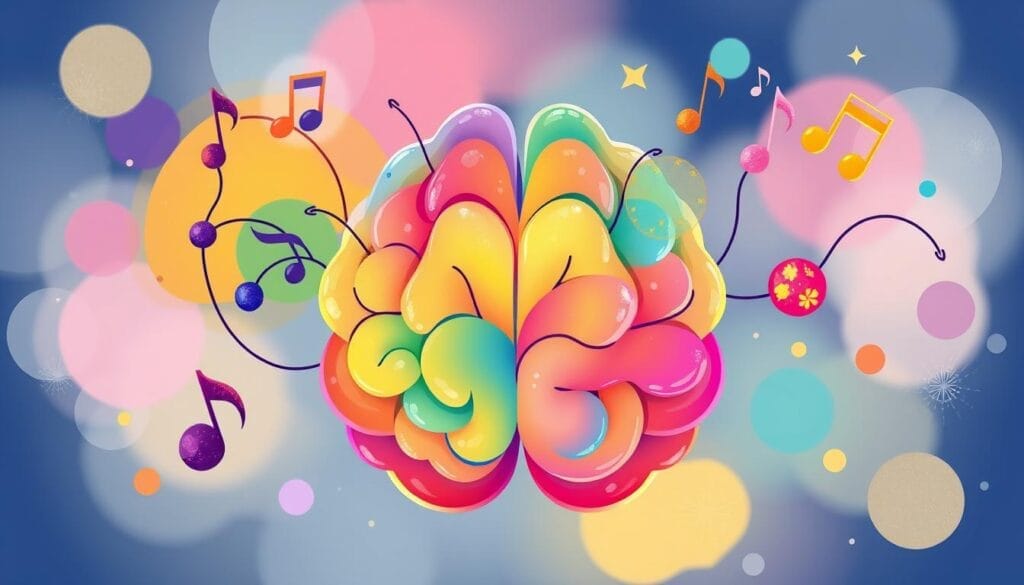
Studies found that using sound therapy early can help kids with ASD learn and respond better. Music therapy gives cues that help kids connect and share experiences. This is important for growing their minds.
Physical Benefits of Music Therapy
Music therapy is a multi-sensory experience that helps children with autism spectrum disorder (ASD) a lot. It uses sounds, sights, touch, and movement to improve their physical skills. This includes fine motor skills and gross motor skills.
Motor Skills Development
Music therapy's rhythm and structure help kids with ASD improve their coordination and motor control. Activities like playing instruments, dancing, or moving to the beat help them practice and get better. This leads to more independence and better self-care.
Coordination through Rhythm
The rhythmic parts of music therapy are especially good for kids with ASD. Moving to the beat helps them get better at coordinating their movements. This improves their physical skills and body awareness.
Music therapy's physical benefits for kids with ASD are huge. It helps them become more independent and confident in their bodies. This leads to better well-being and more chances for success in school and social life.
Real-Life Success Stories
Many case studies and testimonials show how music therapy helps kids with autism. These autism success stories talk about big improvements in talking, social skills, and feeling calm. Parents say their child and family's life gets better with music therapy, showing real music therapy outcomes.
Case Studies of Children Who Thrived
In one classroom, 4 students got music therapy. After a year and a half, the results were amazing. Grace, a student with autism, learned to make sentences with music. Six students, including Grace, will join the 6th-grade choir, showing music therapy's benefits.
Jimmy, another patient, found a way to express himself and feel better in the hospital. Music therapy helped him walk again after breaking his leg.
Parental Testimonials
Parents share amazing stories of music therapy's impact. Ms. A's peaceful passing in a hospice shows music's role in end-of-life care. Larry's family talks about how music therapy improved their daily life.

These stories give us a closer look at music therapy's benefits for autism. The autism success stories and personal experiences from parents and caregivers show music therapy's power. It makes life better for kids with ASD and their families.
Professional Insights
Music therapy is a key tool for helping kids with autism. It's backed by science and works well. Music therapists tailor their methods to meet each child's needs. They use proven techniques to improve communication, social skills, and more.
Perspectives from Music Therapists
Music therapists say music is a big help for kids with autism. They make therapy fit each child's likes and skills. This way, kids can express themselves, make friends, and feel better.
Research Findings and Evidence
- Research shows music therapy boosts social skills and communication in kids with autism.
- It also helps with thinking and language skills.
- Music helps kids with autism engage and grow, improving how they feel and interact.
- Trained music therapists create plans that really help kids with autism, leading to big improvements.
More research is needed to fully understand music therapy's benefits for kids with autism. But the early results are very promising.
How to Get Started with Music Therapy
To start music therapy for a child with Autism Spectrum Disorder (ASD), find a qualified music therapist (MT-BC). They have finished an accredited program, passed a national exam, and have 1,200 hours of training.
Finding Qualified Music Therapists
Music therapists work in schools, private practices, or agencies for ASD. To find one, check the American Music Therapy Association (AMTA) directory. You can also ask local healthcare providers, schools, or autism groups for suggestions.
Setting Goals and Expectations
The first step is an assessment of the child's strengths and needs. The therapist will work with the family to set goals. This might include improving communication, social skills, emotional control, and thinking abilities.
It's key to have realistic goals and talk openly with the therapist. Some places have funding for music therapy through Medicaid Waivers or private insurance might need approval first.
FAQ
What is music therapy, and how does it benefit children with autism?
Music therapy uses music to help people with autism. It helps with behavior, social skills, and more. It makes life better for those with autism.
What are the characteristics of Autism Spectrum Disorder (ASD)?
ASD makes it hard for people to talk and connect with others. It affects how they communicate and feel. It also makes socializing and controlling emotions tough.
What are the techniques used in music therapy for children with ASD?
Music therapy uses music in special ways. It helps kids grow in a positive way. It uses different music styles to help.
How does music therapy improve communication skills in children with ASD?
Music therapy lets kids without words communicate. It helps them talk and speak better. It also helps them share and listen in their own way.
How does music therapy help with emotional and behavioral regulation in children with ASD?
Music therapy helps kids feel better and act better. It makes them happier and less anxious. It's better than just sitting there.
How does music therapy improve social skills in children with ASD?
Music therapy helps kids get along better. It makes them more aware of their body. It also helps them focus and move better.
How does music therapy impact cognitive functioning in individuals with ASD?
Music therapy helps kids pay attention better. Music's rhythm helps their senses work better. It improves how they hear and move.
What are the physical benefits of music therapy for children with ASD?
Music therapy helps kids move better. It improves their fine and gross motor skills. It also helps with coordination and senses.
What do real-life success stories and parental testimonials say about the impact of music therapy on children with ASD?
Many stories show music therapy's good effects. Parents say it helps with talking, socializing, and feeling better. It makes life better for the whole family.
What should I consider when starting music therapy for a child with ASD?
Find a certified music therapist (MT-BC) first. They assess the child and plan goals. Some places cover music therapy through Medicaid or insurance.
How Childhood Trauma Impacts Adult Mental Health
Childhood adversity, or ACEs, has a big impact that lasts a long time. Studies link ACEs to mental health issues like depression and anxiety in adults. Abuse, neglect, and domestic violence can raise the risk of mental illness later on.
Childhood trauma affects how well someone can handle their emotions. This can make it hard to have healthy relationships as an adult. People who faced trauma might turn to harmful coping methods, like substance abuse or self-harm.
By age 16, over two-thirds of kids have seen at least one traumatic event, says SAMHSA. The U.S. Department of Veteran Affairs notes that 3-15% of girls and 1-6% of boys get PTSD from childhood trauma. The NHS in the UK says 1 in 3 new mental health cases in adults come from childhood trauma.
It's important to help kids early to lessen the long-term effects of trauma. Knowing how childhood trauma affects adult mental health helps us support those who have been through it. This way, we can help them heal and move forward.
Understanding Childhood Trauma and Its Forms
Childhood trauma is a range of upsetting experiences. They can deeply affect a child's mind and feelings. Events like abuse, neglect, bullying, and violence can cause lasting harm.
Types of Childhood Trauma
Childhood trauma can be many things, including:
- Physical abuse
- Emotional abuse
- Sexual abuse
- Neglect
- Bullying
- Community violence
- Disasters
- Intimate partner violence
- Medical trauma
- Refugee trauma
- Terrorism
Signs and Symptoms in Children
The signs of childhood trauma vary by age and event. Look for sleep problems, sadness, and nervousness. Also, watch for loss of interest, aggression, and avoiding certain situations.
Children may also have flashbacks or act younger than they are. These signs show emotional and attachment issues. It's important to know these signs to help children heal.
The Connection Between Childhood Trauma and Adult Mental Health
Childhood trauma can deeply affect a person's mental health as an adult. Studies show that those who faced trauma as kids often deal with mood swings, anxiety, and even chronic pain. This can include post-traumatic stress.
Psychological Mechanisms
Childhood trauma can mess up how we handle stress. It makes us feel always on edge and unable to control our emotions. This can lead to serious mental health problems like depression and anxiety.
Long-term Effects on Behavior
Adults who went through trauma as kids might turn to bad habits like drugs or self-harm. They might also get into unhealthy relationships. These actions can make their mental health problems worse.
But, it's important to know that the effects of childhood trauma aren't set in stone. Many people can overcome it. Yet, some face lasting challenges. This shows we need to help early and offer strong support to break the cycle of mental illness.

Impact on Emotional Regulation
Childhood trauma can really mess with how we handle our feelings as adults. People who went through trauma might have trouble controlling their emotions. This can lead to mood swings, outbursts, or feeling numb.
The link between trauma and anxiety is very complex. It often changes how our brain deals with stress and how it sends signals.
Difficulty in Managing Emotions
Survivors of trauma might find it hard to control their feelings. Some turn to self-medication through substance abuse to try and feel better. Emotional problems are common in people with PTSD and other mental health issues.
Relationship Between Trauma and Anxiety
People who faced trauma as kids are more likely to get anxiety. They might be always on edge and startle easily. This shows how their brain's stress response is different.
Studies have shown that trauma can mess with the brain's emotional control centers. This is seen in those who were hurt as kids.
Childhood trauma's effects on emotional control can lead to many problems later in life. It's important to understand how trauma affects our emotions. This knowledge helps us create better ways to support those who have been through trauma.
The Role of Attachment Styles
Childhood trauma can change how people form relationships as adults. Secure attachments help people have healthy relationships. But, insecure attachments can make it hard to trust and be close to others.
Secure vs. Insecure Attachments
Secure attachments make kids feel safe and loved. But, insecure attachments can happen if kids don't get the care they need. This can affect how they relate to others as adults.
Influence on Adult Relationships
Adults with insecure attachments from childhood may face relationship problems. They might find it hard to trust and feel close to others. Knowing about attachment styles helps deal with these issues.
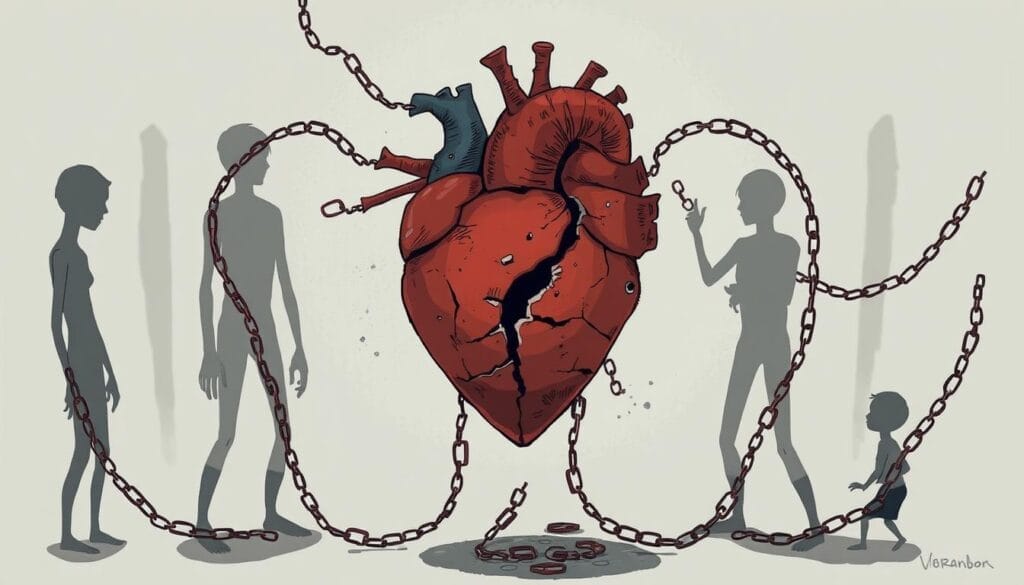
The Neuroscience of Trauma
Childhood trauma can change the brain a lot. It can affect the hippocampus, amygdala, and prefrontal cortex. These changes can mess with emotional control, stress response, memory, and thinking.
Brain Changes Due to Early Trauma
Trauma in early years can mess up brain growth. The hippocampus, which helps with memory, might shrink and not work well. The amygdala, which handles fear, can get too active. This makes it hard to control emotions.
The prefrontal cortex, which helps with thinking and decisions, can also be affected. This can make it hard to think clearly and make good choices. These changes can make someone more likely to get mental illness like depression or PTSD.
Impact on Cognitive Functions
- Attention and concentration: Trauma can make it hard to focus and do tasks.
- Learning and memory: A damaged hippocampus can make it tough to learn new things and remember.
- Decision-making and problem-solving: Problems with the prefrontal cortex can make it hard to make smart choices and solve problems.
Also, trauma can mess with the brain's reward system. This can lead to addiction in adulthood. People might turn to drugs or other bad habits to cope with their trauma.
It's important to understand how trauma affects the brain. This knowledge helps create better treatments. By focusing on both the mind and brain, we can help people heal and grow stronger.
Co-occurring Mental Health Disorders
Childhood trauma can deeply affect a person's mental health. It can lead to more mental health problems later in life. Depression and PTSD are two common ones.
Depression and PTSD
People who faced trauma as kids often deal with depression and PTSD. These conditions can make each other worse. The pain and memories from childhood can make someone feel hopeless and sad.
PTSD symptoms like constant fear and anxiety can also add to the distress. This makes it hard for them to feel better.
Substance Abuse and Self-Medication
Many try to cope with their pain by using drugs or alcohol. It might feel like it helps for a while. But, it can make things worse and lead to addiction.
Substance abuse makes mental health problems even harder to treat. It adds more challenges to getting better.
Dealing with trauma, mental health issues, and addiction is very tough. It needs a deep understanding and special help. Treating the trauma and helping with mental health and addiction is key to recovery.

Coping Mechanisms Developed in Childhood
Children who face emotional issues and mental illness because of trauma often find ways to cope. These ways can be good or bad. Good ones help them deal with trauma's lasting effects. Bad ones can make things worse.
Positive vs. Negative Coping Strategies
Good coping strategies include getting support, solving problems, and being resilient. These help people deal with their feelings and build a strong base for well-being. On the other hand, bad strategies like avoiding problems or taking risks can make things worse.
The Role of Resilience
Being resilient is key to overcoming childhood trauma. Things like having a strong support network, thinking clearly, and finding healing resources help. With resilience, people can face their challenges and grow from their experiences.
Using positive coping strategies, building resilience, and getting help can help adults heal from childhood trauma. Learning about the long-term effects of childhood trauma and symptoms in adulthood is important. It shows why it's crucial to address these issues and work towards a better life.
Therapy and Healing Approaches
Many people struggle with the lasting effects of childhood trauma. Different therapies can help a lot. Cognitive Behavioral Therapy (CBT), Dialectical Behavior Therapy (DBT), and Eye Movement Desensitization and Reprocessing (EMDR) are some of them.
These therapies help people deal with traumatic memories. They also teach new ways to cope with emotions.
Types of Therapeutic Interventions
CBT helps people change negative thought patterns. It also teaches skills for managing feelings. DBT focuses on mindfulness and emotional control.
DBT helps with the tough challenges of PTSD and mental health issues.
EMDR uses eye movements to help process traumatic memories. It helps people separate from the trauma's emotional impact.
Importance of Support Systems
Support from family, friends, and groups is very important. They offer emotional support and help. They also provide a sense of community.
Having a strong support system helps a lot. It makes dealing with PTSD and mental health easier.

Prevention: Building Resilient Children
It's key to help kids bounce back from tough times. Good parenting and community help can do this. We can teach kids to deal with childhood adversity and toxic stress better.
Effective Parenting Practices
Children do well in loving, stable homes. Here, they learn to handle feelings and make friends. Parents can help by:
- Being a steady, caring presence
- Teaching kids how to handle stress and feelings
- Helping kids feel they can control their lives
- Supporting friendships and social groups
Community Support and Resources
Our community can help kids a lot. Programs and services can teach kids and families about trauma. This includes mental health help, family support, and learning tools.
Learning about childhood trauma is important. It helps everyone in the community support kids better.
Preventing childhood trauma is crucial. It helps kids grow strong, even when things get tough. With good parenting and community support, kids can face childhood adversity and toxic stress head-on.
Moving Forward: Finding Hope and Recovery
Recovery from childhood trauma is possible. Many find hope and healing through different paths. Personal stories of overcoming trauma inspire and offer practical insights.
Steps toward mental wellness include seeking professional help and building a support network. Practicing self-care and engaging in personal growth are also important.
Personal Stories of Overcoming Trauma
Survivors of childhood trauma show remarkable resilience. Their stories of perseverance and growth inspire hope. They remind us that healing is a personal and empowering process.
By sharing their experiences, they offer valuable guidance and validation. Their stories help others on similar paths.
Steps Toward Mental Wellness
The journey to mental wellness after trauma is complex. Seeking professional help, like therapists or counselors, is crucial. They offer support and evidence-based treatments.
Building a network of trusted friends and family is also key. Support groups provide emotional validation and practical help. Self-care practices, like mindfulness and exercise, help manage trauma's impact.
The path to recovery is about ongoing personal growth and resilience. It's about creating a fulfilling and meaningful life.
FAQ
What is the impact of childhood trauma on adult mental health?
Childhood trauma can cause lifelong physical and mental health issues. This includes a higher risk of PTSD, depression, anxiety, and substance abuse. It also increases the chance of chronic diseases later in life.
What are the different types of childhood trauma?
Childhood trauma includes physical, emotional, and sexual abuse. It also includes neglect, bullying, and exposure to violence. Other types are medical trauma, refugee trauma, and terrorism.
How does childhood trauma affect brain development and function?
Childhood trauma can change the brain's structure and function. It affects areas like the hippocampus and amygdala. This can alter stress response, memory, and emotional regulation.
What are the common psychological mechanisms by which childhood trauma affects adult mental health?
Childhood trauma can harm emotional regulation and attachment styles. It increases the risk of depression, PTSD, and substance abuse in adulthood.
How does childhood trauma impact relationships and attachment in adulthood?
Childhood trauma can affect trust and intimacy in adult relationships. Understanding these patterns is key to addressing relationship issues.
What are the common long-term effects of childhood trauma on adult behavior and health?
Childhood trauma raises the risk of many leading causes of death. It can lead to poor health, substance abuse, and chronic diseases like diabetes and heart disease.
What are some effective therapeutic interventions for addressing childhood trauma?
Effective treatments include Cognitive Behavioral Therapy (CBT), Dialectical Behavior Therapy (DBT), and Eye Movement Desensitization and Reprocessing (EMDR). These help process traumatic memories and develop coping skills.
How can childhood trauma be prevented, and what are the key strategies for building resilience in children?
Preventing childhood trauma involves creating nurturing environments. Teach emotional regulation and foster social connections. Community resources and early intervention are key for support.
What are the steps toward recovery and mental wellness for individuals who have experienced childhood trauma?
Recovery from childhood trauma is possible. Steps include seeking professional help, building a support network, and practicing self-care. Personal stories of overcoming trauma can inspire and guide others.
Foods to Avoid If You Have Neurological Disorders
Neurological disorders can greatly affect a person's health and happiness. Diet is key in managing these conditions. Foods high in sugar, unhealthy fats, and artificial additives can harm the brain and worsen symptoms.
This article will look at foods to avoid for better brain health. It aims to help manage neurological conditions more effectively.
Dementia is expected to affect over 65 million people worldwide by 2030. This shows how important diet is for brain health. Sugary drinks, for example, contain high-fructose corn syrup.
High-fructose corn syrup has 55% fructose and 45% glucose. Too much fructose can cause obesity, high blood pressure, and diabetes. These issues can harm the brain.
The blood-brain barrier protects the brain. But, some foods can damage it, letting harmful substances in. This can lead to neurological disorders.
Studies show that too many carbs can increase the risk of dementia. Elderly people who eat more carbs have almost double the risk. This highlights the need to watch carb intake.
Understanding Neurological Disorders and Diet
Diet is key to our brain health. Some foods can make symptoms worse or raise the risk of neurological disorders. Knowing how diet affects our brain can help us make better choices.
The Connection Between Diet and Neurological Health
Bad fats, sugars, and processed foods can lead to inflammation and stress in the brain. But, eating anti-inflammatory foods like those in the Mediterranean diet can help. This might lower the risk of diseases like Alzheimer's and Parkinson's.
Common Neurological Disorders Affected by Diet
- Alzheimer's disease: Eating foods rich in omega-3s, antioxidants, and anti-inflammatory compounds may slow it down.
- Parkinson's disease: Eating plant-based foods, whole grains, and healthy fats can help manage symptoms.
- Multiple sclerosis: An anti-inflammatory diet and certain nutrients might reduce inflammation and symptoms.
- Epilepsy: The ketogenic diet, with lots of fat and little carbs, can help control seizures in some cases.

Understanding diet's role in brain health lets us make choices that support our brain. This can help lessen the impact of these conditions.
Foods High in Sugar
Sugary treats might taste good, but too much sugar is bad for your brain. Research shows that too much sugar can hurt memory and learning. It can even lead to dementia. Drinks like soda and fruit juice are especially bad because they have a lot of fructose.
Impact of Sugar on Brain Function
Sugar makes dopamine, a chemical that makes us feel good. This can make us want more sugar, leading to unhealthy eating habits. Also, sugary foods can cause inflammation, which is bad for our brains and overall health.
Alternatives to Sugary Foods
- Choose water, unsweetened tea, or low-sugar drinks instead of sugary ones.
- Eat fresh fruits, veggies, or nuts to satisfy cravings and get important nutrients for your brain.
- Try healthy sugar substitutes like honey, maple syrup, or stevia in small amounts.
- Eat more whole, unprocessed foods to cut down on added sugars.

By choosing to eat less sugar and picking healthier options, you can help keep your brain sharp. This can also lower the chance of brain diseases linked to too much sugar.
Processed Foods and Preservatives
Foods we eat are key to our brain health. Processed foods often have bad stuff like artificial additives and preservatives. These can hurt our brain's function.
These foods are full of calories, unhealthy fats, and sugars. But they lack the good stuff our bodies need. Eating too much of these foods can lead to brain problems and memory loss.
Studies show that eating too much processed food is bad for our brains. It can cause memory loss and other brain issues.
Common Additives to Avoid
Some bad additives in processed foods include artificial sweeteners and MSG. Food dyes are also a no-go. These can harm our health, especially our brains.
Healthy Alternatives to Processed Foods
- Eat more whole foods like fruits, veggies, lean proteins, and grains.
- Choose clean eating with lots of whole foods and less artificial stuff.
- Try making your own food with natural ingredients. It's good for your brain and health.
By picking whole foods over processed ones, you help your brain. You also lower the risk of health problems from artificial additives.

Trans Fats and Saturated Fats
The fats we eat can really affect our brain health. Eating too much of trans fats and saturated fats can raise the risk of brain diseases. This includes Alzheimer's disease and losing brain function.
How Fats Affect Brain Health
Eating a lot of trans fats can hurt your memory and increase the risk of Alzheimer's. Trans fats are in fried foods, baked goods, and processed snacks. They cause inflammation and mess with the brain's work.
While the science on saturated fats is not clear, it's wise to eat less of them. They might also harm brain health.
Sources of Healthy Fats
We should eat more healthy fats, especially omega-3 fatty acids. Omega-3s help keep the brain healthy and fight off brain decline. Here are some good sources:
- Fatty fish, such as salmon, mackerel, and sardines
- Nuts and seeds, like walnuts, chia seeds, and flaxseeds
- Avocados
- Olive oil
Choosing the right fats can help our brain work better. It also lowers the chance of brain diseases.

Gluten and Its Effects
Not everyone with neurological disorders must avoid gluten. But those with gluten sensitivity or celiac disease should. Symptoms include brain fog, headaches, and neuropathy.
Understanding Gluten Sensitivity
Celiac disease, wheat allergy, and non-celiac gluten sensitivity (NCGS) are gluten-related disorders. Celiac disease can cause serious health issues like anemia and stunted growth. Wheat allergy leads to allergic reactions and needs a wheat-free diet.
People with celiac disease and NCGS must avoid all gluten. This means no gluten-containing foods.
Gluten-Free Alternatives to Consider
Grains to avoid include wheat, barley, rye, and triticale. Also, farina, spelt, kamut, wheat berries, farro, and couscous. Commonly avoided foods include most breads, crackers, wraps, and baked goods.
Also, wheat-based pastas, certain snack foods, and processed foods are off-limits. But, there are many gluten-free foods to enjoy. Fruits and vegetables, legumes, and gluten-free grains are good choices.
Animal proteins, nuts, seeds, and healthy fats are also safe. Look for brands like Simple Mills, Purely Elizabeth, and Jovial Foods for gluten-free options.
When eating out, choose protein sources and gluten-free grains. Avoid fried foods and check the menu for gluten-free options. Bringing your own salad dressings is a good idea.
Alcohol Consumption
Too much alcohol can harm your brain a lot. It messes with how your brain talks to itself. This can cause memory problems, confusion, and raise the risk of brain diseases. Drinking in moderation might help some, but it's wise to keep it low.
If you have a brain disorder, talk to your doctor about drinking. Even a little alcohol can mess with your meds or make symptoms worse.
Effects of Alcohol on Neurological Health
Drinking too much can hurt your brain a lot. It can lead to many brain problems. For example, up to 46% of people with alcohol-related myopathy see their strength go down a lot.
Also, drinking too much can damage the part of the brain that helps you walk and talk right. This can cause you to walk funny, shake, slur words, and move in jerky ways.
Recommended Guidelines for Alcohol Intake
Drinking a little might be good for you, but know the limits. Health experts say women should have no more than one drink a day. Men can have up to two.
But if you have a brain problem, see a neurologist first. They can tell you how much alcohol is safe for you. This way, you won't make your brain problems worse.
Caffeine and Neurological Disorders
Caffeine is a popular stimulant. The average American adult drinks about 179 mg of it every day. This is like drinking two cups of coffee. While it can help with thinking, too much can be bad for some people.
The Risks of High Caffeine Intake
Drinking more than three cups of coffee a day can cause problems. These include anxiety, trouble sleeping, and shaking. People with Parkinson's disease are especially at risk.
Too much caffeine can even cause poisoning. This leads to many symptoms in the brain.
Some genes make people more likely to get Alzheimer's disease. This is true for menopausal women. Also, some genes can raise the risk of Parkinson's disease in men.
Alternatives to Caffeinated Beverages
- Herbal teas: Herbal teas like chamomile, valerian, and lavender can provide a soothing, caffeine-free alternative to traditional caffeinated beverages.
- Decaffeinated coffee: For those who enjoy the taste of coffee, decaffeinated options can offer the flavor without the stimulant effects.
- Caffeine-free energy drinks: Beverages made with ingredients like green smoothies, coconut water, or yerba mate can provide a natural energy boost without the potential drawbacks of high caffeine consumption.
Research on caffeine and brain health is not all the same. But, people with brain disorders should be careful with caffeine. Trying other drinks and drinking less can help. This way, they can still enjoy caffeine's good effects but avoid its bad ones.
Dairy Products: What You Need to Know
For people with neurological disorders, dairy might be a problem. Lactose or casein, the main proteins in dairy, can cause inflammation. This can make symptoms worse. Dairy is good for nutrients, but it's not for everyone with neurological issues.
Potential Issues with Dairy
Research shows dairy, especially low-fat kinds, might raise Parkinson's disease risk. The proteins in dairy could cause inflammation. Some studies found dairy might slightly increase Parkinson's risk in both men and women.
Non-Dairy Alternatives
- Plant-based milks like almond, soy, or oat milk are good for those with lactose intolerance or casein sensitivity.
- Dairy-free yogurts and cheeses made from nuts or soy are also options.
- These plant-based milk alternatives have nutrients like regular dairy but don't trigger neurological symptoms.
People with neurological disorders should watch what they eat. If they think dairy is a problem, they should cut it out. Talking to a doctor about diet changes can help manage their condition.
Importance of a Balanced Diet
Eating a balanced diet is key for keeping your brain healthy. Eating foods rich in nutrients helps your brain work well. It may also lower the chance of getting brain diseases.
Key Nutrients for Neurological Health
Good for your brain are omega-3s, antioxidants, B vitamins, and vitamin D. Omega-3s, found in wild salmon, help your brain. Antioxidants in turmeric and berries fight stress and help your brain grow.
B vitamins and vitamin D are important for energy and protecting your brain.
Tips for Maintaining a Healthy Diet
To eat well for your brain, plan your meals and cook at home. Try to eat foods that are full of nutrients. The Mediterranean diet and MIND diet are good for your brain. They include whole grains, lean proteins, fruits, veggies, and healthy fats.
Choosing the right foods helps keep your brain healthy. It's a way to take care of your brain.
FAQ
What is the connection between diet and neurological health?
Diet is very important for our brain health. Some foods help our brain work well. Others can make neurological problems worse. Eating right can help our brain stay healthy.
What are some common neurological disorders affected by diet?
Diet affects many brain diseases. These include Alzheimer's, Parkinson's, multiple sclerosis, and epilepsy. Bad fats, sugars, and processed foods can increase the risk of these diseases.
How does excessive sugar intake affect brain health?
Too much sugar harms our brain. It can make memory and learning hard. It also raises the risk of dementia. We should eat less sugar and choose healthier drinks.
What types of processed foods and additives should be avoided?
Avoid foods with bad additives. These include artificial sweeteners and MSG. Instead, eat whole foods like fruits, veggies, and lean proteins.
How do trans fats and saturated fats affect the brain?
Trans fats are bad for our brain. They increase Alzheimer's risk and harm memory. Saturated fats are not as clear, but healthy fats like omega-3s are good for our brain.
Can gluten sensitivity or celiac disease cause neurological symptoms?
Yes, gluten can cause brain problems for some. Symptoms include brain fog and headaches. People with gluten issues should avoid gluten and choose gluten-free foods.
How does excessive alcohol consumption affect neurological health?
Too much alcohol harms our brain. It can cause memory loss and confusion. It's best to drink less, especially if you have brain diseases.
What are the potential risks of high caffeine intake for individuals with neurological disorders?
Too much caffeine can be bad for brain health. It can make anxiety worse and disrupt sleep. Try herbal teas or decaf coffee instead.
Can dairy products be problematic for those with neurological disorders?
Some people with brain issues may react to dairy. Dairy can cause inflammation. Try non-dairy options like plant-based milk and yogurt.
What are the key nutrients for supporting neurological health?
Our brain needs omega-3s, antioxidants, B vitamins, and vitamin D. Eating a balanced diet helps our brain stay healthy. Focus on whole foods and healthy fats.
Top 10 Common Neurological Disorders and Their Symptoms
Neurological disorders affect millions of people every year. They impact the brain, spine, and nerves. This can change daily life a lot and needs special medical care.
Many people don't know they have a neurological condition. Knowing the symptoms is key for getting the right treatment. The top 10 include Alzheimer's, Parkinson's, epilepsy, and more.
These brain disorders show up in many ways. You might forget things, have tremors, or feel nerve pain. It's important to notice these signs early and see a doctor fast.
By knowing about these disorders and their symptoms, you can protect your brain. This helps you get the right care and support.
1. Alzheimer's Disease: A Slow Decline in Memory
Alzheimer's disease is a condition that makes memory and thinking skills get worse over time. It's the main reason for dementia in older adults. Knowing the symptoms, stages, and effects of Alzheimer's is key for early treatment.
Key Symptoms of Alzheimer's Disease
Early signs of Alzheimer's include forgetting recent things, trouble with words, getting lost, and mood swings. As it gets worse, people might forget more, struggle with solving problems, and find daily tasks hard. These issues can really change someone's life and how independent they can be.
Stages of Alzheimer's Disease
Alzheimer's is split into three stages: mild, moderate, and severe. In the mild stage, people might forget things and show small changes in thinking. The disease gets worse, making memory and thinking problems more obvious, and needing more help with daily tasks. In the severe stage, people might not talk, know their family, or take care of themselves.
Impact on Daily Life
Alzheimer's can greatly affect someone's daily life. It can make it hard to keep up with friends, handle money, and live alone. Family and caregivers are very important in helping those with Alzheimer's. Getting diagnosed early and getting the right help can make a big difference in their life and the lives of their loved ones.
2. Parkinson's Disease: Tremors and Stiffness
Parkinson's disease is a condition that affects how we move. It happens when the brain can't make enough dopamine. This is important for smooth movements.
People with Parkinson's may have movement disorders. They might shake or feel stiff.
Early Signs of Parkinson's Disease
In the beginning, Parkinson's can be hard to notice. But there are signs. These include:
- Reduced sense of smell
- Constipation
- Facial stiffness, making it hard to smile
Advanced Symptoms of Parkinson's Disease
As Parkinson's gets worse, symptoms get stronger. They can really change daily life. Advanced symptoms include:
- Tremors - These start in the hands or fingers.
- Muscle Stiffness - This makes it hard to move and limits motion.
- Changes in speech, like it being softer and sounding the same all the time.
- Reduced facial expressions, known as "masked face."
- Difficulty with balance and walking.
Parkinson's usually starts around 60. Symptoms get worse over time. Doctors can diagnose it by talking about symptoms and doing a physical check. Luckily, there are treatments that can help manage symptoms and improve life quality.

To learn more about Alzheimer's disease and other dementias, visit this informative resource.
3. Epilepsy: The Challenge of Seizures
Epilepsy is a brain disorder that causes seizures. It affects about 3 million people in the U.S. Seizures are when the brain's electrical activity changes. They can make people lose consciousness or have jerky movements.
It's important to know the different types of seizures and why they happen. This helps in managing the condition better.
Different Types of Seizures
Seizures are divided into focal and generalized types. Focal seizures start in one part of the brain. They can cause strange feelings, movements, or confusion.
Generalized seizures affect the whole brain. They can make people lose consciousness, have muscle spasms, or convulsions.
Causes of Epilepsy
Epilepsy can be caused by many things. These include brain injuries, genetics, and developmental disorders. About half of those with seizure disorders don't know why they have them.
Research has found many genes linked to epileptic seizures.
Coping Mechanisms for Patients
Managing convulsions and seizures is key to a good life. Treatment often includes medicine to control seizures. It helps prevent memory loss and brain damage.
Changing your lifestyle, joining support groups, and talking to doctors can also help. Finding the right treatment is important for each person.
Thanks to research, most people with epilepsy can control their seizures. Understanding epilepsy helps doctors and patients work together. This improves life for those with seizure disorders.
4. Multiple Sclerosis: A Disease of the Immune System
Multiple Sclerosis (MS) is an autoimmune disorder that affects the central nervous system. The body's immune system attacks the protective myelin sheath around nerve fibers. This leads to inflammation, scarring, and damage to the central nervous system.
This damage disrupts normal nerve function. It causes a wide range of symptoms that vary among individuals.
Symptoms of Multiple Sclerosis
The most common symptoms include fatigue, vision problems, numbness, tingling, weakness, balance issues, and cognitive difficulties. These symptoms can change in severity and worsen over time.
Types of Multiple Sclerosis
- Relapsing-remitting MS (RRMS): This is the most common type. It has clearly defined attacks followed by periods of no symptoms.
- Primary progressive MS (PPMS): This type gets worse steadily from the start. There are no clear relapses or remissions.
- Secondary progressive MS (SPMS): It starts as RRMS but gets worse steadily over time. There may be occasional relapses and minor remissions.
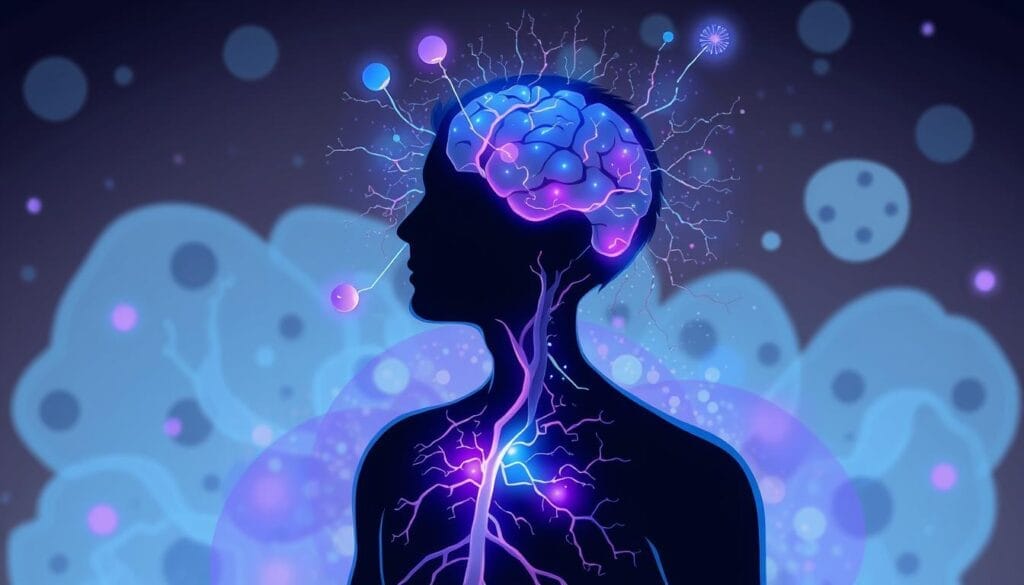
Diagnosing MS often requires a clinical evaluation, MRI scans, and spinal fluid analysis. There is no cure, but treatments help manage symptoms and slow the disease. These include corticosteroids, disease-modifying therapies, and rehabilitation programs.
5. Migraine: More Than Just a Headache
Migraines are severe headaches that happen often. They affect kids and adults. People think they're just bad headaches, but they're much more.
These headaches can really mess up your day. They can make life hard for those who get them.
Triggers for Migraines
Many things can start a migraine. Stress, certain foods, and hormonal changes are common triggers. Some people get migraines because of their family history.
Native Americans and those living in poverty are more likely to get migraines. This shows that genetics and environment play a big role.
Common Symptoms of Migraines
- Intense, throbbing head pain
- Sensitivity to light and sound
- Nausea and vomiting
- Visual disturbances known as "aura"
Migraines can hit anyone, but women get them more often. Hormones play a big part. People with migraines also face mental health issues and sleep problems.
Treatment Options for Migraines
There are many ways to treat migraines. You can try over-the-counter pain meds or prescription drugs. Preventive meds can help too.
Some people find relief in vitamins, minerals, and herbs. Relaxation techniques can also help. Finding the right treatment is key.
Managing migraines means using meds and changing your lifestyle. It's important to avoid triggers. Talking to a doctor helps create a plan that works for you.
6. Stroke: Recognizing the Signs
Strokes happen when blood flow to the brain stops. This can be because of a blocked blood vessel or bleeding in the brain. It's very important to know the signs of a stroke and get help right away. Quick action can help a lot and prevent lasting damage.
Symptoms of a Stroke
The most common signs of a stroke are:
- Sudden numbness or weakness, especially on one side of the body
- Confusion, trouble speaking or understanding speech
- Vision problems in one or both eyes
- Dizziness, loss of balance, or lack of coordination
- Severe headache with no known cause
Types of Strokes
There are two main types of strokes:
- Ischemic Stroke: This is when a blood vessel gets blocked. It stops blood and oxygen from reaching the brain.
- Hemorrhagic Stroke: This is when there's bleeding in the brain. It usually happens when a blood vessel bursts.
Recovery Process Post-Stroke
Recovering from a stroke is hard and different for everyone. It depends on how bad the brain damage is. Therapy helps people get back some of what they lost. It's also important to prevent another stroke by taking medicine and making healthy choices.
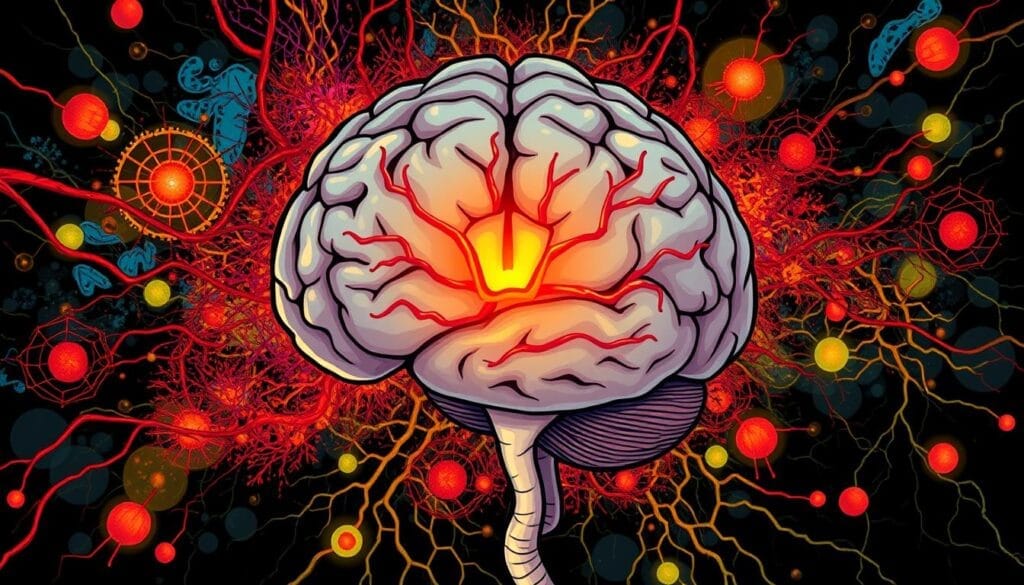
Strokes are a big cause of disability and death in the U.S. Women, Hispanics, and African Americans are at higher risk. Knowing the signs and acting fast can greatly improve treatment and recovery chances.
7. Amyotrophic Lateral Sclerosis (ALS): A Fatal Condition
Amyotrophic Lateral Sclerosis (ALS), also known as Lou Gehrig's disease, is a serious motor neuron disease. It harms the nerve cells that control voluntary muscles. This disease causes muscle weakness, making it hard for patients to do daily tasks. It eventually leads to complete paralysis.
Symptoms of ALS
The first signs of ALS include muscle twitching, weakness, and trouble with coordination. As it gets worse, patients may have trouble speaking, swallowing, and breathing. These symptoms of ALS can differ from person to person, making it hard to spot early.
Stages of ALS Progression
ALS goes through several stages, starting with mild muscle weakness and ending in complete paralysis. The disease can be broken down into the following stages:
- Early stage: Mild muscle weakness and twitching, often in the hands, feet, or limbs.
- Middle stage: Increased muscle weakness, leading to difficulties with tasks like walking, speaking, and swallowing.
- Late stage: Severe muscle weakness and paralysis, requiring mechanical assistance for breathing and other vital functions.
There is no cure for Lou Gehrig's disease yet. But treatments and care can help manage symptoms and improve life quality. Researchers are working hard to find better therapies and a cure for this serious condition.
8. Huntington's Disease: A Genetic Disorder to Watch
Huntington's disease is a rare, inherited disorder that harms brain cells. It's caused by a bad gene passed down from parents. Symptoms start between 30 and 50 years old, causing motor, cognitive, and emotional problems.
Symptoms of Huntington's Disease
The main sign is chorea, or uncontrolled movements. These start in fingers, face, and limbs. Later, balance, swallowing, and speech can be hard.
Cognitive decline leads to memory and planning issues. Mood swings, depression, and irritability are also common.
Genetic Testing and Counseling
Huntington's disease is inherited in an autosomal dominant way. This means a 50% chance of getting it if a parent has it. Genetic testing can show if you have the gene. Counseling helps those at risk understand their options.
There's no cure yet, but treatments can help manage symptoms. Research aims to find better treatments and a cure for this disorder.
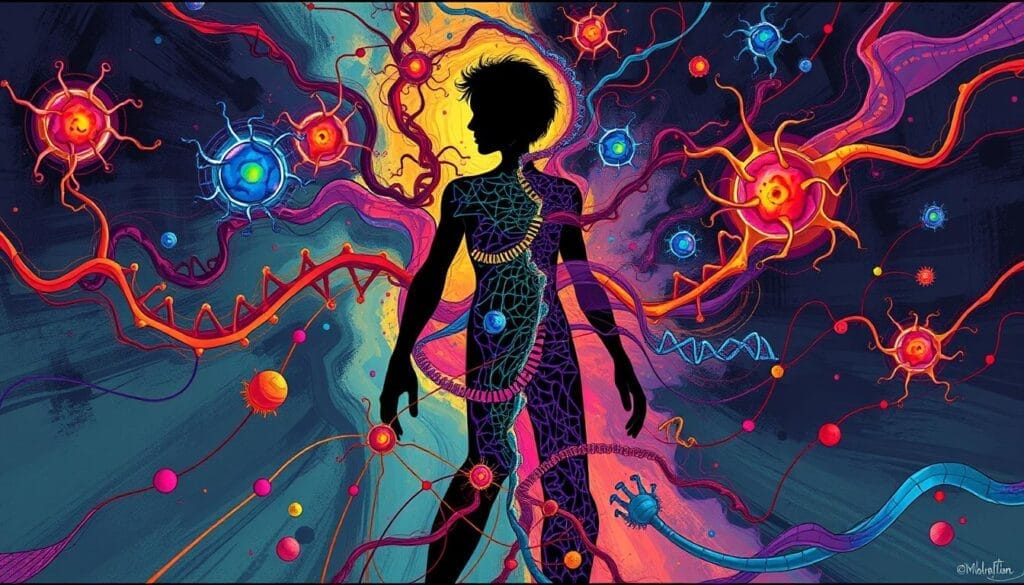
9. Essential Tremor: A Common Rhythm Disorder
Essential tremor is a common movement disorder. It affects about 5% of the world's population. This condition makes hands shake, especially when moving. It's not deadly but can really affect daily life.
Symptoms of Essential Tremor
The main sign is shaking or trembling. It often happens in the hands, head, voice, and other parts. This shaking gets worse when you try to move on purpose, like reaching for something.
Some people also shake their head or neck. This can make their head move up and down or side to side.
As time goes on, the shaking can get worse. It might even spread to other parts of the body. People with essential tremor might also have trouble thinking, walking, and coordinating their hands and eyes.
Treatment Options Available
- Medications: Beta-blockers and anti-seizure drugs are often used to help manage symptoms.
- Lifestyle changes: Reducing stress, avoiding caffeine, and using relaxation techniques can help.
- Surgical interventions: Deep brain stimulation or focused ultrasound therapy might be options for severe cases.
Essential tremor can't be cured, but these treatments can help manage symptoms. It's important to see a neurologist regularly. This is because the condition can get worse over time.
10. Peripheral Neuropathy: A Nerve Condition
Peripheral neuropathy is a nerve problem. It happens when nerves outside the brain and spinal cord get damaged. This can cause nerve damage, numbness, and tingling. It's a common issue in the U.S., affecting millions, with over 100 types.
Diabetes is a big cause of this problem. High blood sugar can harm nerves over time. Other reasons include chemotherapy, infections, injuries, some medicines, and diseases like Guillain-Barré syndrome.
How it shows up can vary. Some people have mild symptoms, while others face severe nerve damage. Doctors use physical exams, blood tests, and nerve tests to find the cause. They then create a treatment plan for each person. Early treatment is key to managing this complex issue.
FAQ
What are the most common neurological disorders?
Common neurological disorders include Alzheimer's and Parkinson's disease. Also, epilepsy, multiple sclerosis, and migraines are common. Other disorders are stroke, ALS, Huntington's disease, essential tremor, and peripheral neuropathy.
What are the key symptoms of Alzheimer's disease?
Alzheimer's symptoms include forgetting recent events and trouble with language. You might also feel disoriented or have mood changes. The disease gets worse, leading to severe dementia.
What are the early and advanced symptoms of Parkinson's disease?
Early Parkinson's signs are a reduced sense of smell and constipation. Facial stiffness is also a sign. As it gets worse, you might have tremors and speech changes. Advanced symptoms include trouble balancing and walking.
What are the different types of seizures associated with epilepsy?
Epilepsy seizures can cause loss of consciousness and jerking movements. You might also feel confused or have emotional changes. These symptoms vary.
What are the symptoms and types of multiple sclerosis?
Multiple sclerosis symptoms include fatigue and vision problems. You might feel numbness, tingling, or weakness. Balance and cognitive issues are also common. There are different types of MS, each with its own symptoms and treatment.
What are the common triggers and symptoms of migraines?
Migraine triggers are stress, certain foods, and hormonal changes. Symptoms include intense pain, sensitivity to light and sound, and nausea. You might also see visual disturbances called aura.
What are the symptoms and types of strokes?
Stroke symptoms include sudden numbness or weakness, confusion, and trouble speaking. You might also have vision problems, dizziness, and a severe headache. There are two main types: ischemic and hemorrhagic.
What are the symptoms and stages of ALS?
ALS starts with muscle weakness, twitching, and coordination issues. As it gets worse, you might have trouble speaking and swallowing. Eventually, you could have trouble breathing. ALS progresses to complete paralysis and respiratory failure.
What are the symptoms of Huntington's disease and how is it diagnosed?
Huntington's symptoms include involuntary movements and psychiatric problems. You might also experience cognitive decline. It's a genetic disorder, diagnosed with genetic testing.
What are the symptoms and treatment options for essential tremor?
Essential tremor causes rhythmic shaking, often in the hands. It can also affect the head, voice, and other parts of the body. Treatment includes medications, lifestyle changes, and sometimes surgery like deep brain stimulation.
What are the common causes and symptoms of peripheral neuropathy?
Peripheral neuropathy is caused by damage to the nervous system. This can be due to diabetes, chemotherapy, infections, or injuries. Symptoms include numbness, tingling, and weakness, starting in the hands and feet.
The Connection Between Nerve Damage and Chronic Pain
Chronic pain affects about 7-8% of people. It often comes from nerve damage. When nerves don't work right, pain can keep coming even after injuries heal.
The nervous system can change in ways that cause pain. Nerve damage can lead to changes in how nerves work. This can make pain worse and harder to manage.
Chronic pain from nerve damage can last for a long time. It can really hurt a person's life. To manage it, doctors use many treatments, like surgery and medicine. They also look for other health issues that might be causing the nerve damage.
Understanding Chronic Pain: An Overview
Chronic pain is a long-lasting and very hard condition. It affects millions of Americans every year. It's different from acute pain, which helps protect us. Chronic pain can last for months or years, really hurting our quality of life. Knowing the types and causes of chronic pain is key to managing it well.
What is Chronic Pain?
Chronic pain lasts more than three months or longer than expected healing times. It can come from nerve damage, inflammation, or other medical issues. This pain makes it hard to do daily tasks, work, and live a happy life.
Common Causes of Chronic Pain
The main reasons for chronic pain are:
- Nerve damage or neuropathic pain
- Inflammation, like in arthritis or other inflammatory conditions
- Underlying medical conditions, such as cancer, diabetes, or fibromyalgia
Types of Chronic Pain
There are many types of chronic pain, each with its own features and causes:
- Nociceptive Pain: This pain comes from tissue damage or inflammation, like in arthritis or injuries.
- Neuropathic Pain: This pain is from nerve damage or problems, making pain feel stronger or different.
- Nociplastic Pain: This pain is from changes in how the central nervous system handles pain signals, making us more sensitive to pain.
It's very important for doctors to know about these different types and causes of chronic pain. This helps them create better treatment plans. It also improves the lives of those dealing with this tough condition.
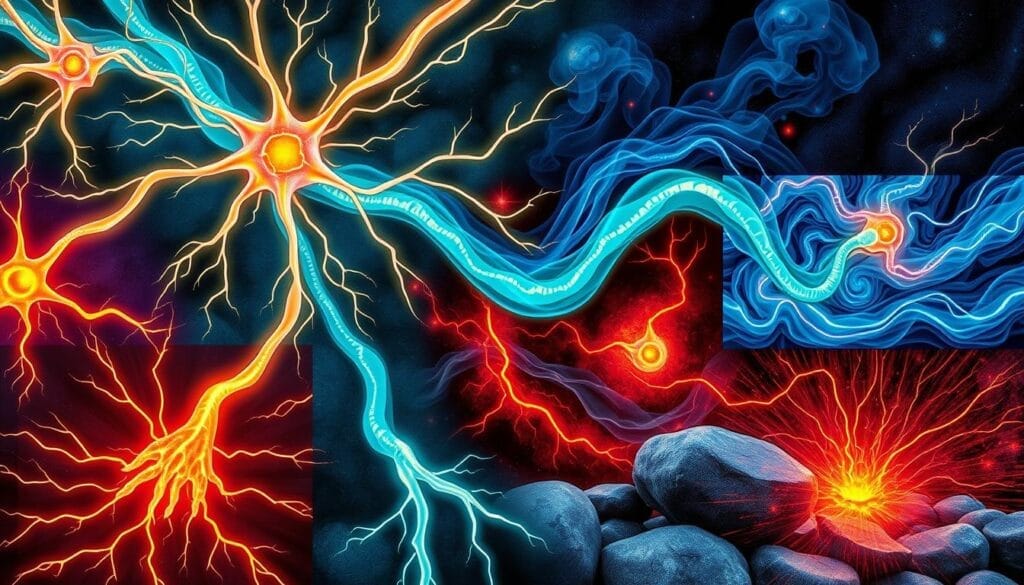
What is Nerve Damage?
Nerve damage, also known as neuropathy, happens when nerves get hurt or don't work right. This can cause burning, numbness, tingling, and weakness. It can really change someone's life, making it hard to move, feel things, and enjoy life.
Definition and Types of Nerve Damage
Nerve damage can be different, like peripheral neuropathy, neuralgia, and radiculopathy. Peripheral neuropathy is common and can be caused by diabetes, nerve injury, or toxins. Neuralgia is sharp pain in one spot, and radiculopathy affects nerve roots, causing pain that spreads.
Symptoms of Nerve Damage
The signs of nerve damage can vary. Here are some common ones:
- Numbness or tingling in the affected area
- Burning, stabbing, or shooting pain
- Muscle weakness or loss of coordination
- Sensitivity to touch or temperature changes
- Difficulty sleeping due to pain
The Impact of Nerve Damage on Daily Life
Nerve damage can really affect daily life. It can make simple tasks hard, like walking or dressing. The pain and discomfort can also mess with sleep, mood, and social activities.
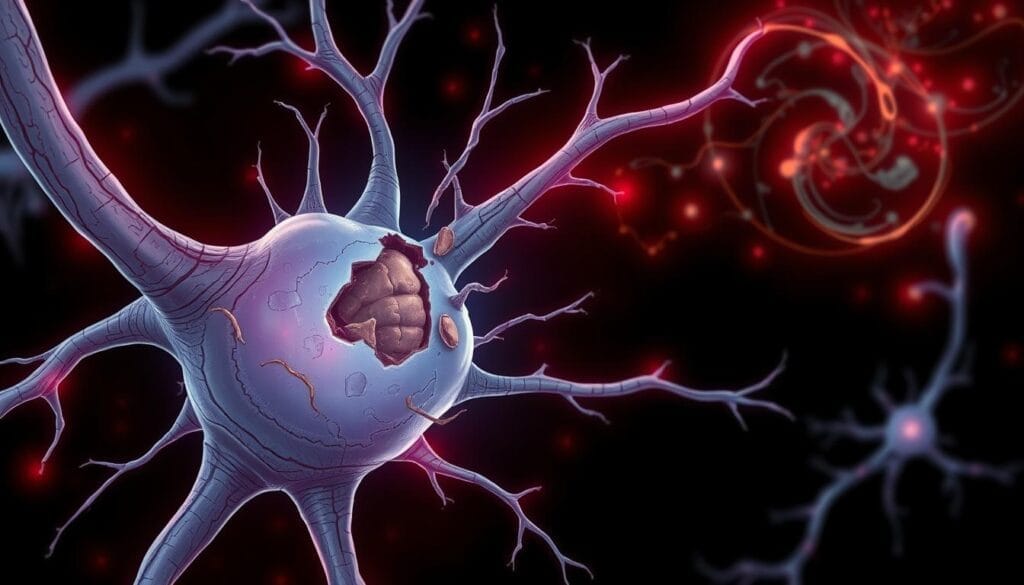
Getting nerve damage treated early is key. A mix of medicines, physical therapy, and lifestyle changes can help. This way, you can lessen the long-term effects and feel better overall.
How Nerve Damage Leads to Chronic Pain
Nerve damage changes how we feel and send pain signals. When the somatosensory nervous system gets hurt, it can lead to a bad change. This change makes us feel chronic, neuropathic pain.
The Mechanism of Pain Transmission
Nerve damage can make us feel pain without any reason. It also makes us feel more pain from things that don't hurt. This changed nerve function is a big part of chronic pain.
Neuropathic Pain Explained
Neuropathic pain comes from nerve damage or problems. About one in ten Americans has this pain. It's hard to manage because it changes the nervous system a lot.
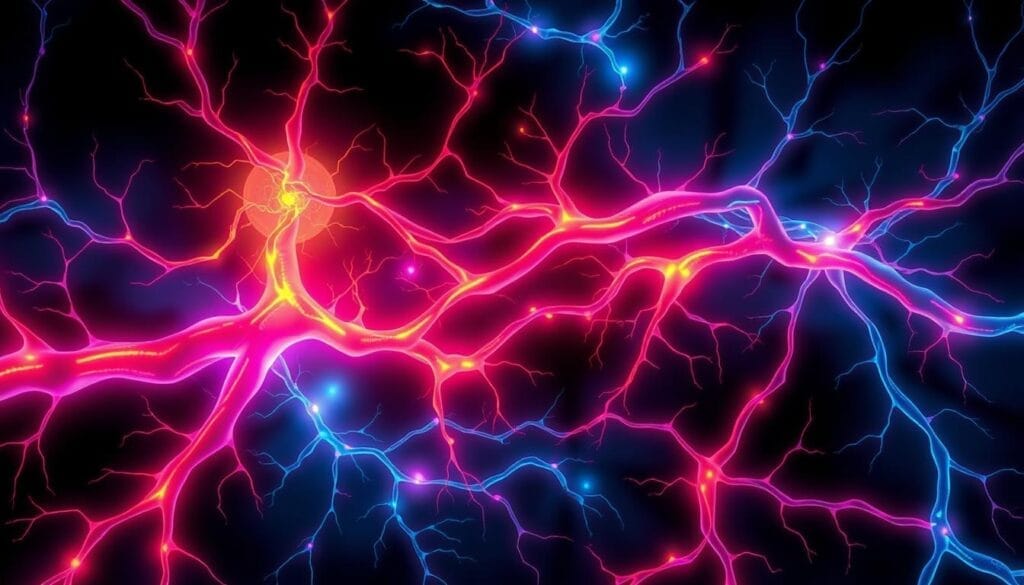
Researchers found important things about neuropathic pain. They found genes and neurotransmitters that play a big role. New treatments, like antibodies and cell-based ones, might help manage pain transmission and central sensitization in neuropathic pain.
The Role of Inflammation in Chronic Pain
Inflammation is key in chronic pain. It involves cytokines, chemokines, and growth factors. These activate nociceptors, making us more sensitive to pain. This leads to more pain, as the brain starts to amplify these signals.
How Inflammation Affects Nerve Health
Long-term nerve inflammation harms nerve function. It messes with the nervous system's signals. This makes pain last even after the injury heals.
Chronic Inflammation and Pain Sensitivity
The immune and nervous systems work together, but chronic inflammation makes us more sensitive to pain. Cytokines like interleukin-6 and tumor necrosis factor-alpha affect pain neurons. This makes pain signals stronger and can lead to neuropathic pain.

It's important to understand how inflammation causes chronic pain. By tackling the inflammation, doctors can help patients. This improves their lives and quality of life.
Diagnosing Chronic Pain and Nerve Damage
Finding the cause of chronic pain and nerve damage is key to treating it. Doctors start with a detailed medical history and physical check-up. Then, they use special tests to help figure out what's wrong.
Importance of a Comprehensive Evaluation
Figuring out chronic pain and nerve damage needs a careful look. Doctors use many methods, like a neurological assessment. This helps find the pain's source and how much nerve damage there is.
Common Diagnostic Tests
- Electromyography (EMG): This test checks muscle electrical activity. It helps doctors see if nerves are damaged.
- Nerve Conduction Studies: These tests look at how well nerves send signals. They show if nerves are working right or not.
- Imaging Techniques: MRI, CT scans, and X-rays help see if there are any problems in the body that could be causing pain or nerve damage.
Getting a correct pain diagnosis and neurological assessment is very important. Doctors might use a special grading system to see how bad the nerve damage is. This helps them plan the best treatment.
With a full check-up, people with chronic pain and nerve damage can get the right care. This helps them manage their pain and live better.
Treatment Options for Chronic Pain
Living with chronic pain is tough, but there are ways to help. You can try different treatments like medicine, physical therapy, and other methods. A mix of these can really help manage pain and make life better.
Medications for Managing Pain
Medicine is key in fighting chronic pain. Drugs like ibuprofen and Celebrex help with swelling and pain. Acetaminophen is good for mild pain, like in your back or joints.
For nerve pain, like in fibromyalgia, antidepressants and anti-seizure meds work well. But, they might make you feel a bit sick or sleepy. Opioids are strong but can be dangerous, leading to addiction.
Physical Therapy and Rehabilitation
Physical therapy is super important for chronic pain. It helps you move better and get stronger. Exercises and special therapies can cut down pain and boost your health.
Alternative Therapies
There are also other ways to fight pain, like acupuncture and massage. Mindfulness and water therapy can help too. These methods focus on the mind and body, offering a complete pain solution.
Finding the right treatment for chronic pain is all about what works for you. It's about working together with your doctor to find the best mix of treatments. This way, you can manage your pain and live a better life.
Managing Nerve Damage
Fixing nerve damage needs a mix of medical help and lifestyle changes. Starting early is key to stop things from getting worse. It helps those with nerve problems a lot.
Lifestyle Changes for Nerve Health
Changing your lifestyle can really help your nerves. Here are some tips:
- Eat a diet full of vitamins and minerals to keep your nerves healthy.
- Do some light exercise to help your nerves grow back.
- Try stress-reducing activities like meditation to protect your nerves.
- Stay away from harmful things like alcohol and cigarette smoke.
- Get enough sleep to help your nerves heal.
Importance of Early Intervention
Starting treatment early is very important. Quick action can make a big difference. It helps stop things from getting worse.
Doctors can create a plan to help you. This might include medicine, therapy, and lifestyle changes. It's all about helping your nerves get better.
Managing nerve damage well is key to keeping your life good. It helps avoid pain, disability, and other serious problems. By working together, you can get better and look forward to a brighter future.
The Psychological Impact of Chronic Pain
Chronic pain is more than just physical pain. It can really hurt your mental health. [https://drchandrilchugh.com/neuropathy/what-is-neuropathy-an-overview/] People with chronic pain often feel sad, anxious, and their life quality drops. The fight against pain can make you feel down, lonely, and hopeless, making recovery harder.
Mental Health Challenges Related to Chronic Pain
Studies show people with chronic pain are three times more likely to get depressed. [https://drchandrilchugh.com/neuropathy/what-is-neuropathy-an-overview/] Chronic pain and mental health issues are closely linked. It makes you more aware of pain and less able to handle it. It can also change how your brain works, making mental health issues worse.
Coping Strategies for Chronic Pain
It's key to tackle the mental side of chronic pain to manage it well. Good ways to cope include:
- Cognitive-behavioral therapy (CBT) to change negative thoughts and find better ways to cope
- Mindfulness-based practices, like MBSR and MBCT, to lessen pain and boost mood
- Stress-reducing activities, like yoga, deep breathing, and meditation, to handle pain's emotional effects
- Joining support groups for emotional support and advice from others facing similar issues
Using these pain psychology and mental health methods can help manage chronic pain. It can also improve how well you cope with it.
Living Well with Chronic Pain and Nerve Damage
Living well with chronic pain and nerve damage needs a plan. It's about building a strong support system and setting goals for getting better. Many people with chronic pain don't stay active. But, being active can help manage daily tasks and stop pain from getting worse.
Creating a Support System
Joining support groups and doing guided activities can help a lot. Working with healthcare providers is also key. These steps can make people with chronic pain and nerve damage feel less alone. They get the help and motivation they need to handle their condition.
Setting Realistic Goals for Recovery
Setting goals that you can reach is important. It keeps you motivated and shows you're making progress. Using strategies for daily tasks and managing pain can greatly improve life. Even if a cure isn't possible, many people can live well with the right care and support.
FAQ
What is the connection between nerve damage and chronic pain?
Nerve damage can mess up how pain signals are sent. This can cause pain even after injuries heal. Understanding this link helps in finding better treatments for chronic pain.
What are the different types of chronic pain?
There are several types of chronic pain. Nociceptive pain helps protect us. Neuropathic pain comes from nerve damage. Inflammatory pain happens after tissue injury.
Dysfunctional pain is from nervous system problems without damage.
What are the common types of nerve damage?
Common nerve damage includes peripheral neuropathy, neuralgia, and radiculopathy. Symptoms include burning, numbness, tingling, and weakness. This damage can really affect daily life.
How does nerve damage lead to chronic pain?
Nerve damage changes how the nervous system works. This leads to constant pain and more sensitivity to pain. It creates a condition that makes pain harder to manage.
What is the role of inflammation in chronic pain development?
Inflammation is key in chronic pain. It makes pain signals stronger. Long-term inflammation can make pain worse by changing how we feel pain.
How is chronic pain and nerve damage diagnosed?
Diagnosing chronic pain and nerve damage needs a full check-up. This includes a medical history, physical exam, and tests like electromyography. Getting the right diagnosis is important for treatment.
What are the treatment options for chronic pain?
Treating chronic pain often involves many approaches. This includes medicines, physical therapy, and sometimes nerve blocks or surgery. Each plan is made for the person's specific needs.
How can nerve damage be managed?
Managing nerve damage needs medical help and lifestyle changes. Starting treatment early is key. Changes like diet, exercise, and stress management can help. Managing other health issues is also important.
How does chronic pain impact mental health?
Chronic pain can really affect mental health. It can lead to depression and anxiety. Therapy, mindfulness, and stress reduction can help. Support groups offer emotional support and advice.
How can individuals living with chronic pain and nerve damage improve their quality of life?
Living well with chronic pain means having a strong support system. Setting realistic goals and finding ways to manage pain are important. While there's no cure, many people can live fulfilling lives with the right support.
What Causes Hemiplegia? A Closer Look at Risk Factors
Hemiplegia is a serious condition that causes partial or total paralysis on one side of the body. It can be caused by many things, like stroke, brain injury, tumors, or infections. Knowing what causes hemiplegia helps us treat it better and improve lives.
Stroke is the main cause of hemiplegia, affecting about 80% of stroke survivors. Other health issues like diabetes, high blood pressure, and epilepsy can also raise the risk. Infections in the eyes, ears, or brain can also lead to hemiplegia if not treated.
Brain injuries from accidents or falls can also cause hemiplegia. So can brain tumors that affect motor skills. The severity and where in the brain the injury is can affect how bad the symptoms are.
Hemiplegia can greatly change a person's life, affecting their physical, emotional, and social health. Treatment like physical, occupational, and speech therapy is key. It helps people with hemiplegia regain function and live better lives.
Understanding Hemiplegia and Its Impact
Hemiplegia is a condition where one side of the body is paralyzed. This happens when the brain or spinal cord is damaged. It affects how the body moves and can change daily life a lot.
Definition of Hemiplegia
Hemiplegia means one side of the body is weak or paralyzed. It usually comes from a stroke, brain injury, or other brain problems.
Common Symptoms of Hemiplegia
People with hemiplegia often have weak muscles and trouble moving. They might find it hard to walk, hold things, or stay balanced. They can also have problems with thinking and remembering things.
How Hemiplegia Differs from Other Paralysis Types
Hemiplegia is different from other paralysis because it affects only one side. Hemiparesis, for example, is just muscle weakness, not full paralysis. There are different kinds of hemiplegia, like facial paralysis, each with its own symptoms.
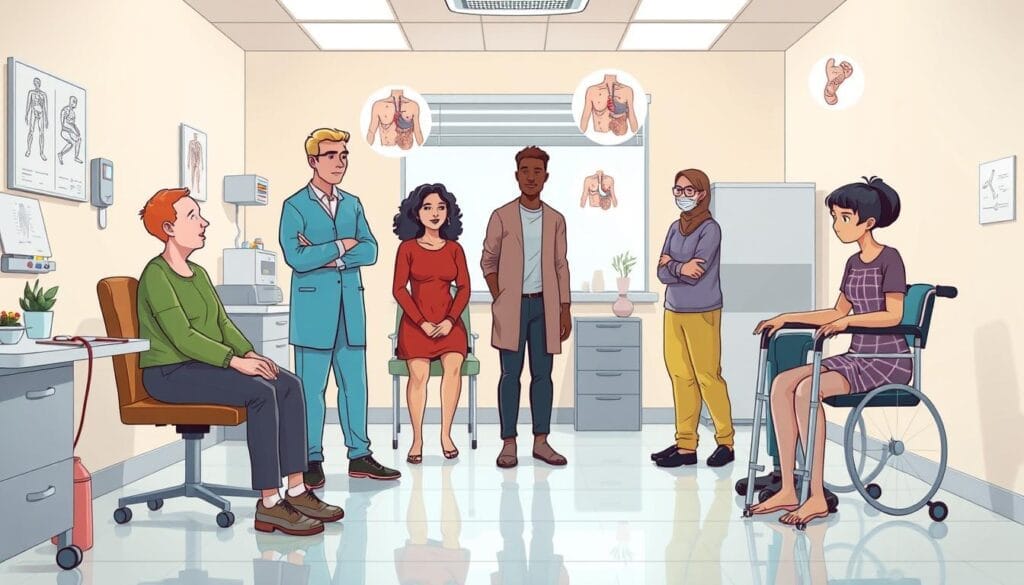
Hemiplegia can really change someone's life. It affects their independence and how they move. Knowing about it helps us support those who have it better.
Neurological Conditions Leading to Hemiplegia
Hemiplegia is a paralysis that affects one side of the body. It can come from many neurological conditions. Knowing the causes is key for the right treatment.
Stroke is the top cause, making up over 50% of cases. It's a serious condition that blocks blood flow to the brain.
Stroke: The Leading Cause
Stroke is a medical emergency that can kill brain cells. It happens when blood flow to the brain stops. This can cause hemiplegia, with symptoms on the opposite side of the body.
Brain Injury and Its Consequences
Traumatic brain injuries (TBIs) from accidents or falls can also cause hemiplegia. These injuries can damage neural pathways. This leads to poor motor function and paralysis on one side.
Tumors Affecting Motor Function
Brain tumors, especially in the motor cortex, can cause hemiplegia. They disrupt the brain's motor control centers. As they grow, they press on nearby nerves, causing movement problems.
Other conditions like multiple sclerosis and cerebral palsy can also lead to hemiplegia. They affect movement and quality of life. Quick action and treatment are vital for recovery.
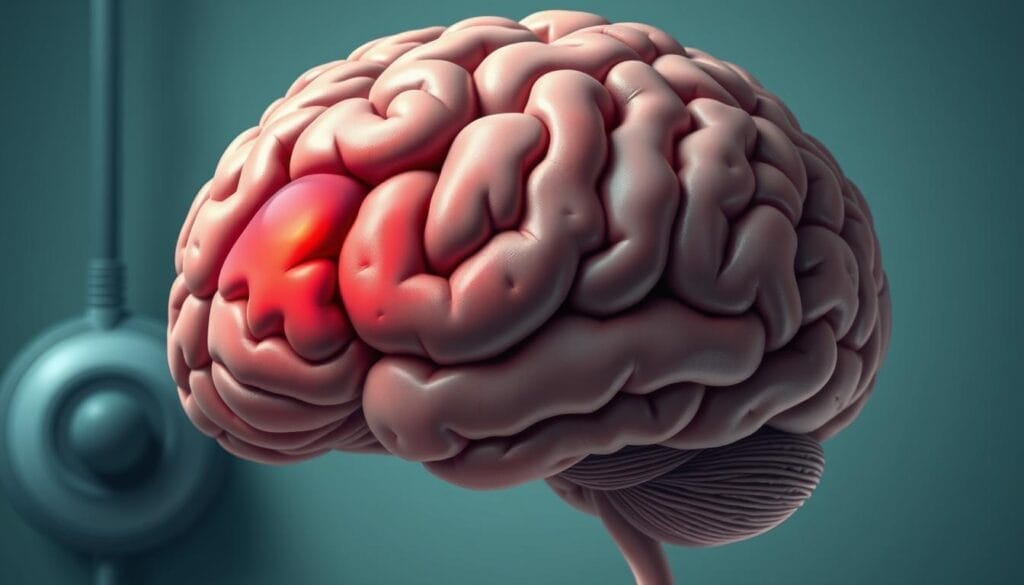
Risk Factors Associated with Hemiplegia
Knowing the risk factors for hemiplegia is key. It helps spot who might get this serious condition. Hemiplegia often comes from stroke, the main cause.
Age: Who Is at Greater Risk?
Age is a big factor in getting hemiplegia. Babies under 12 months and people over 55 are at high risk. The risk goes up with each decade after 55 because our bodies age.
Pre-existing Health Conditions
Some health issues raise the risk of hemiplegia. High blood pressure, high cholesterol, obesity, and kidney disease can harm blood vessels. This reduces blood flow to the brain, leading to hemiplegia. Stroke is the most common cause, and these conditions are big contributors to stroke risk.
Lifestyle Choices and Their Impact
- Smoking: Smoking doubles the risk of developing hemiplegia, as it can damage blood vessels and increase the likelihood of stroke.
- Excessive Alcohol Consumption: Heavy alcohol use can lead to brain damage and increase the risk of hemiplegia.
- Lack of Physical Activity: Sedentary lifestyles and lack of exercise can contribute to the development of health conditions that increase the risk of hemiplegia.
Some groups, like Black, American Indian, Alaska Native, and Hispanic people, face a higher stroke risk. This means a higher risk of hemiplegia. Family history and certain blood types (AB) also play a part.
By knowing these risk factors, people can lower their chance of getting hemiplegia. They can live healthier, manage health issues, and get medical help fast if symptoms show up.
Genetic Factors in Hemiplegia
Genetic causes are a big part of hemiplegia. Some hereditary conditions can make blood clotting or blood vessel strength issues. This can lead to stroke and hemiplegia. Also, certain genetic mutations, like in the ATP1A3 gene, can cause a rare form of hemiplegia called alternating hemiplegia of childhood (AHC).
Hereditary Conditions
Hereditary conditions can raise the risk of hemiplegia. These include disorders that affect blood vessels or blood clotting. Knowing your family's health history can help spot genetic risks for hemiplegia.
Genetic Mutations Linked to Neurological Disorders
Some genetic mutations are linked to neurological disorders that can cause hemiplegia. For example, mutations in the ATP1A3 gene lead to alternating hemiplegia of childhood (AHC). Other genetic disorders can also cause hemiplegia. People with a family history of stroke or neurological disorders might be at higher risk.

It's important to understand the genetic causes of hemiplegia. This helps with early diagnosis and treatment. Regular health checks, genetic tests, and monitoring can help manage genetic risks.
The Role of Infections in Hemiplegia
Hemiplegia is when one side of the body gets paralyzed or weak. It can happen because of brain infections. Viral infections can cause encephalitis, or brain inflammation, leading to hemiplegia. Also, bacterial meningitis, which inflames the brain and spinal cord, can cause this condition.
It's important to treat infections quickly. This is because they can spread to the brain and cause hemiplegia. Some infections might only cause temporary paralysis. But others can lead to permanent brain damage and lasting paralysis.
Viral Infections and Brain Damage
Some viral infections, like those causing encephalitis, can harm the brain. They can get into the brain and cause inflammation. This disrupts how the brain works. Quick diagnosis and treatment are key to avoiding permanent brain damage.
Bacterial Meningitis and Its Effects
Bacterial meningitis is another cause of hemiplegia. It's an inflammation of the brain and spinal cord's protective membranes. This can damage brain tissue and lead to hemiplegia. Quick antibiotic treatment is needed to avoid long-term brain damage.

Knowing how infections cause hemiplegia helps us prevent and manage it. Being alert and getting medical help fast is crucial. This way, we can reduce the harm from infections on the brain's functions.
Environmental Factors Contributing to Hemiplegia
Hemiplegia is a condition where one side of the body is paralyzed or weak. It can be caused by environmental toxins. These toxins can harm the brain, especially during fetal development or early childhood.
Exposure to Toxins
Studies have found that toxins like lead, mercury, and pesticides can harm brain development. This can lead to brain damage and increase the risk of hemiplegia. Keeping the environment clean and safe is key, especially for pregnant women and young kids.
Impact of Prenatal Factors
Prenatal factors, like infections or drug use, can also affect brain development. They can lead to hemiplegia. Getting proper prenatal care can help lower these risks.
Understanding and tackling environmental factors linked to hemiplegia is important. Healthcare professionals and individuals can work together to reduce risks. Regular check-ups and careful use of harmful substances are crucial. These steps can help lower the chance of hemiplegia caused by environmental factors.
Rehabilitation and Management of Hemiplegia
Rehabilitation is key in managing hemiplegia, which is paralysis on one side of the body. A team of healthcare experts works together. They help people with hemiplegia move better, get stronger, and do daily tasks.
Physical Therapy Approaches
Physical therapy is a big part of treating hemiplegia. It helps regain movement and avoid other problems. Therapists use methods like CIMT, exercises, and special gait training. These help patients get stronger and move better.
Role of Occupational Therapy
Occupational therapy is very important for people with hemiplegia. It helps them learn to do daily tasks again. Therapists work on fine motor skills and hand-eye coordination. They help with dressing, bathing, and grooming.
Importance of Speech Therapy
Speech therapy is key for those with hemiplegia. It helps with speech, language, and swallowing issues. Therapists use special techniques to improve speaking and swallowing. This makes communication and meals safer.
With a full rehabilitation plan, people with hemiplegia can regain their independence. They can also improve their life quality a lot.
Coping Strategies for Individuals with Hemiplegia
Living with hemiplegia, a condition that causes paralysis on one side of the body, can be tough. But, with the right strategies and support, people can overcome these challenges. They can stay independent and live fulfilling lives.
Emotional and Psychological Support
Getting professional help is key for those with hemiplegia. It's important to deal with feelings like depression, anxiety, and feeling left out. Therapists use methods like cognitive-behavioral therapy to help people cope and feel in control again.
Building a Support Network
- Meeting others who have hemiplegia can be very helpful. Support groups, online or in-person, offer a place to share and learn. They help build a community.
- Getting family and friends involved in your recovery is good too. Teaching them about hemiplegia helps them support you better.
- Changing your home and learning new ways to do things can keep you independent. Occupational therapists can suggest tools and strategies for daily tasks.
Coping with hemiplegia needs a mix of physical and emotional help. By getting professional support, building a strong network, and adapting, people can thrive. They can lead happy and meaningful lives.
Moving Forward: Research and Innovations
Ongoing hemiplegia research aims to better understand this condition. It seeks to develop new treatments. Studies are exploring the brain's ability to change, stem cell therapies, and new ways to help patients.
Current Studies on Hemiplegia Causes
Researchers are studying the causes of hemiplegia. They focus on genetic factors and environmental influences. They are looking at how genes and environment affect hemiplegia.
Future Research Directions and Hope for Patients
The future of hemiplegia research is promising. New technologies like robotics and virtual reality are being used in therapy. These help improve motor skills and quality of life.
Gene therapy and personalized treatments are also being developed. These offer new hope for patients and their families.
FAQ
What is hemiplegia and what are its common symptoms?
Hemiplegia is a condition where one side of the body is partially or fully paralyzed. Symptoms include muscle weakness and stiffness. It also makes walking and grasping objects hard.
People with hemiplegia might have trouble balancing and remembering things. They might also find it hard to focus.
What are the main causes of hemiplegia?
Most cases of hemiplegia come from strokes, which cause about 80% of cases. Other causes include brain injuries, tumors, and diseases like multiple sclerosis.
Cerebral palsy and infections that harm the brain or spinal cord can also cause it.
Who is at a higher risk of developing hemiplegia?
Older people and young kids under 12 months are at higher risk. Adults over 55 and those with health issues like high blood pressure are also at risk.
Smoking, not being active, and having a family history of neurological disorders can also increase risk.
How can genetic factors contribute to hemiplegia?
Some genetic conditions can make strokes more likely, leading to hemiplegia. Certain genes, like the ATP1A3 gene, can cause rare types of hemiplegia.
What role do infections play in the development of hemiplegia?
Viral and bacterial infections can cause brain inflammation and damage. This can lead to hemiplegia. Quick treatment is key to avoid lasting damage.
How is hemiplegia typically managed and rehabilitated?
Treatment involves physical, occupational, and speech therapy. These help improve mobility and daily skills. Assistive devices and strategies help regain independence.
What are some effective coping strategies for individuals living with hemiplegia?
Seeking professional help and building a support network are crucial. Adapting the home and learning new daily tasks are also important. Emotional support from loved ones is vital.
What are the current research and future directions for improving hemiplegia treatment?
Research focuses on neuroplasticity, stem cells, and new rehab methods. Robotics and virtual reality may improve motor skills. Gene therapy aims to treat genetic causes, offering personalized treatments.
The Importance of Neurological Health Checkups
Keeping the nervous system healthy is key for overall wellness. Regular checkups are vital for monitoring brain health and catching issues early. These tests, done by neurologists or medical experts, look at the brain, spinal cord, and nerves. They give important insights into your neurological health.
These checkups include a detailed look at symptoms, medical history, and physical assessments. They help doctors spot early signs of brain and nerve problems. This allows for quick action and better care for conditions.
By making regular checkups a priority, you can keep your brain and nervous system in top shape. This ensures they work well and helps catch problems early. Taking care of your neurological health improves your life and supports long-term well-being.
Understanding Neurological Health
Neurology is a medical field that deals with the nervous system. This includes the brain, spinal cord, and nerves. Doctors use tests to check how well these parts work and find problems.
What Is Neurology?
The nervous system controls many important things. It handles movement, feeling, thinking, and behavior. Neurologists are experts who help with issues like headaches, sleep problems, and memory loss. They also deal with serious diseases like multiple sclerosis and Alzheimer's.
Common Neurological Disorders
Here are some common neurological problems:
- Headaches (e.g., migraines, tension-type headaches)
- Sleep disorders (e.g., insomnia, sleep apnea)
- Memory loss and cognitive impairment
- Stroke and cerebrovascular diseases
- Neurodegenerative diseases (e.g., Parkinson's, Alzheimer's, Huntington's)
- Epilepsy and seizure disorders
- Traumatic brain injuries
- Multiple sclerosis and other autoimmune disorders
Doctors check many things during a neurological exam. They look at mental status, nerve function, and how well you move. They also check balance, reflexes, and how you sense things. This helps them figure out what's wrong and how to fix it.
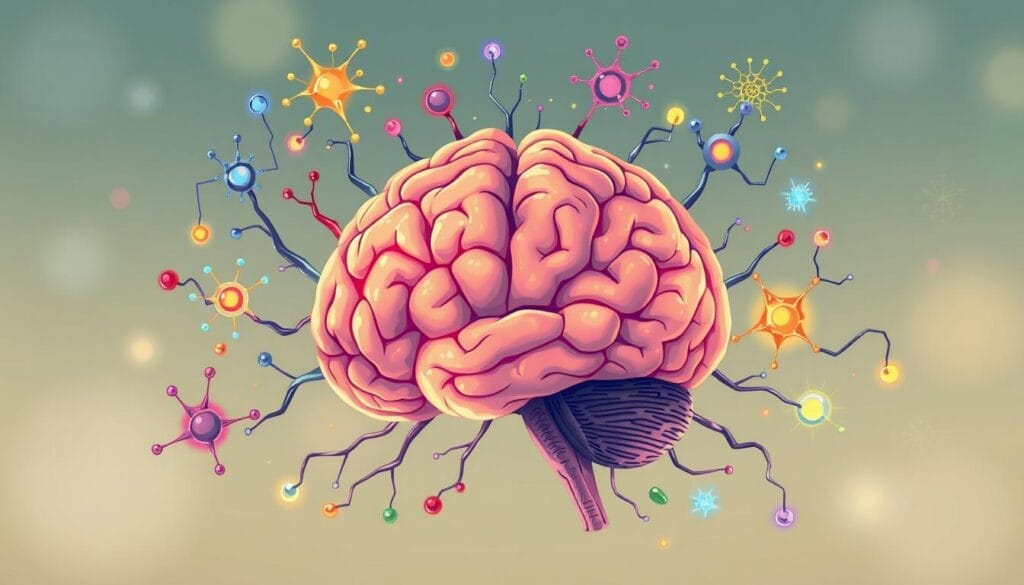
Why Regular Checkups Matter
Good neurological health is key to feeling well. Regular checkups help a lot. They catch problems early and help fix them before they get worse.
Early Detection of Issues
Regular checkups find problems early. This includes things like brain tumors and Alzheimer's. Finding these early means better treatment and less worry for everyone.
Monitoring Existing Conditions
- People with conditions like epilepsy need regular checkups. It helps see how the disease is changing and adjust treatments.
- These visits help notice any changes in symptoms. They guide changes in medication and help manage the condition better.
- By being careful and working with doctors, people can live better with their conditions.
Regular checkups are a smart choice for health. They help manage conditions early and improve life quality.
Recommended Age for Checkups
Keeping your brain healthy is important at every age. From babies to seniors, regular Neurological Health Checkups help spot problems early. They make sure your brain works well. Let's look at when you should get these important tests.
Children and Neurological Health
Young kids get checked with head size and reflex tests. These tests show if a child's brain is growing right. Kids should get Neurological Health Checkups and Brain Function Tests at certain times, like:
- 12 months
- 15 months
- 18 months
- 2 years
- 3 years
- 4 years
Adults: When to Start
Adults should also get regular Neurological Health Checkups and Cognitive Assessments. But, if you have a family history of brain problems or notice odd symptoms, start sooner. The best time to start these tests is:
- Early adulthood (18-40 years old)
- Middle adulthood (41-64 years old)
- Late adulthood (65 years and older)
Being proactive with Neurological Health Checkups helps keep your brain in top shape. It's a smart way to stay healthy for years to come.
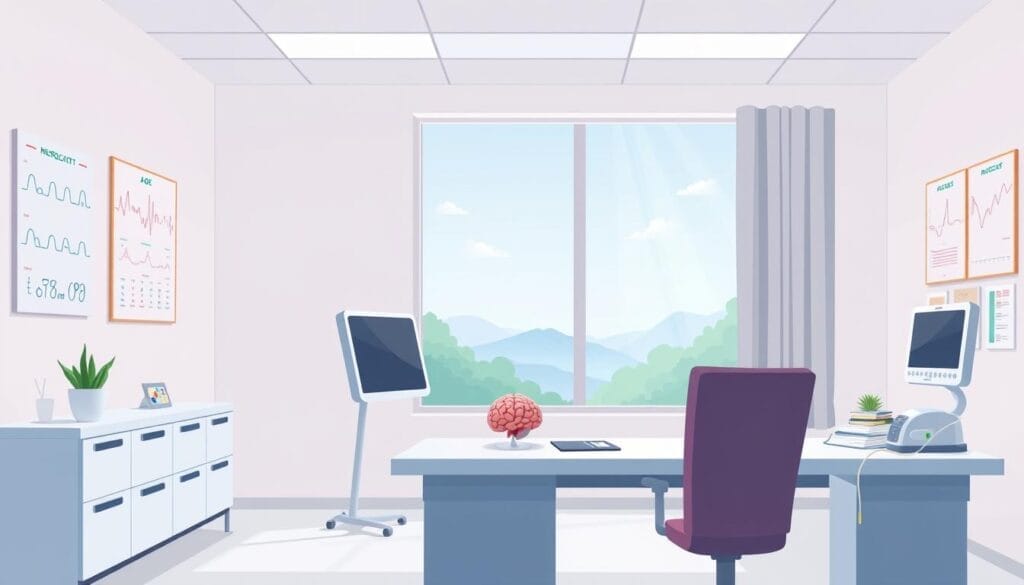
Signs You Need a Checkup
Keeping your brain healthy is key to feeling good. Regular checkups are a must. But, some signs mean you should see a neurologist sooner. These signs include headaches and changes in how you think.
Symptoms to Watch For
Here are some symptoms that might mean you need to see a neurologist:
- Persistent or severe headaches
- Changes in vision, balance, or coordination
- Numbness, tingling, or weakness in the limbs
- Unexplained tremors or seizures
- Memory lapses or changes in cognitive function
- Unexplained pain or sensations
Lifestyle Factors to Consider
Some lifestyle choices might mean you need more checkups. These include:
- Doing activities that could hurt your head
- Being around toxins that harm your brain
- Having health issues like diabetes or high blood pressure
- Having family members with brain problems
Being proactive and getting neurological evaluations early can help. This way, you can catch and fix problems before they get worse. Early action is crucial for your brain's health.
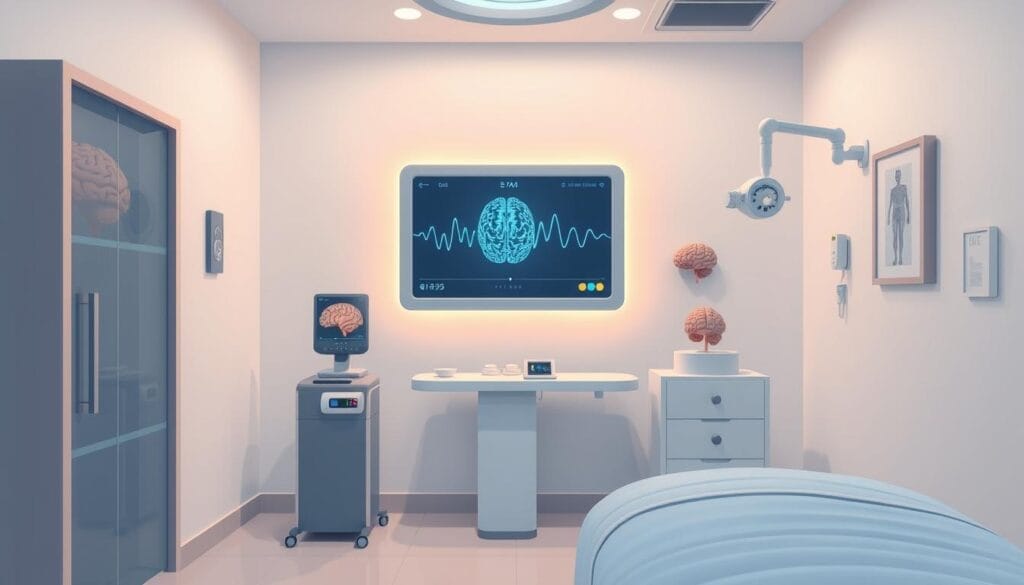
What to Expect During a Checkup
A thorough neurological checkup is key for brain and nervous system health. It covers Attention Deficit Diagnosis, Dementia Screenings, and Neurological Disorder Evaluations. These tests help spot and manage many neurological problems early on.
Initial Consultation Process
The checkup starts with talking about your health history and symptoms. A neurologist or a trained healthcare worker will ask about your nervous system issues. They'll also ask about any changes in how you think or feel.
Diagnostic Tests Overview
The physical exam then checks how well your nervous system works. It looks at:
- Mental status and thinking skills
- Cranial nerve function (like eye and tongue movements)
- Motor skills and balance
- Reflexes and how you feel things
- How your body's automatic systems work (like blood pressure)
Based on what they find, they might do more tests. These could be blood work, genetic tests, or scans like MRI or CT. These help see the brain's structure and activity, spotting any problems.
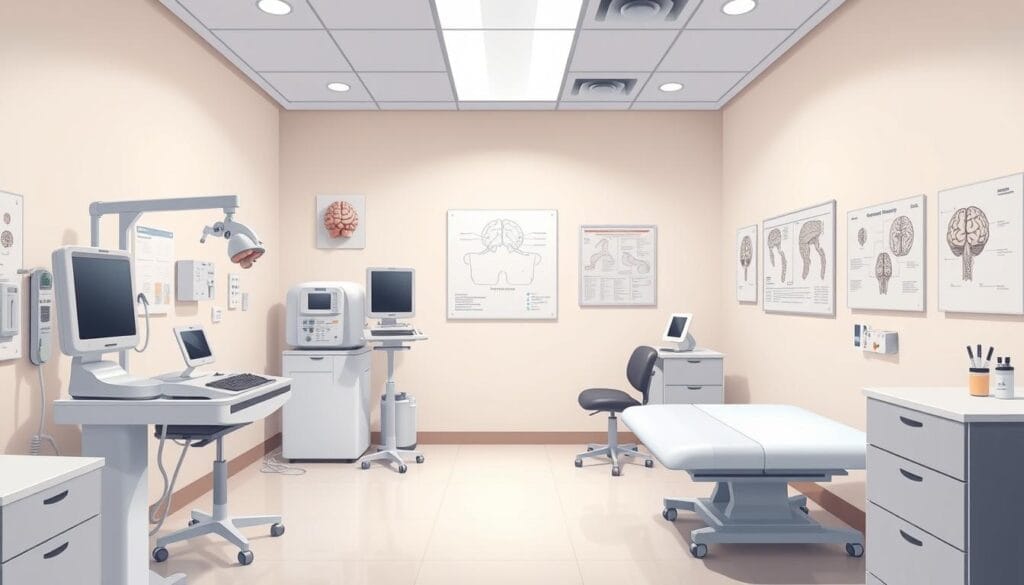
The detailed nature of the checkup makes sure any issues are found and handled. This leads to better care and management of your neurological health.
Benefits of Neurological Health Checkups
Regular neurological health checkups have many benefits. They help find problems early and manage current ones better. These checks are key to keeping your brain healthy and improving your life.
Improved Quality of Life
Neurological checkups can spot small brain changes early. This means you can get help before things get worse. It helps keep your brain and body working well.
Better Management of Conditions
People with brain or nerve issues get better care with regular checks. Doctors can adjust treatments and keep an eye on how the disease is growing. This makes life better for those dealing with these issues.
By focusing on brain health, you can catch and manage problems early. This is a smart way to take care of your brain and overall health.
Choosing the Right Specialist
Choosing the right specialist for your neurological health is key. Neurologists are doctors who deal with the nervous system. This includes the brain, spinal cord, and nerves. It's important to find a neurologist who fits your specific needs.
Types of Neurologists
Neurologists specialize in different areas. For example:
- Movement disorders (e.g., Parkinson's disease, Huntington's disease)
- Epilepsy and seizure disorders
- Stroke and vascular neurology
- Neuromuscular disorders (e.g., myasthenia gravis, amyotrophic lateral sclerosis)
- Pediatric neurology
- Headaches and migraines
- Neuropsychological Evaluations and Neurocognitive Screenings, including Memory Tests
Factors to Consider
When picking a neurologist, think about these things:
- Credentials and Experience: Choose a board-certified neurologist with lots of experience. This means they know how to help you best.
- Communication Style: Find a neurologist who talks clearly and listens well. They should explain things in a way you can understand.
- Availability and Accessibility: Think about where their office is, how easy it is to get an appointment, and if they take your insurance. This affects how easy and affordable your care will be.
Talking to your primary care doctor can help you find the right neurologist. They might have good suggestions based on their own experiences or who they know.
Preparing for Your Appointment
Scheduling a neurological checkup is key to keeping you healthy. To get the most from your visit, prepare well. Start by making a list of your symptoms. Include when they started and how they affect your day-to-day life.
Questions to Ask Your Doctor
At your appointment, ask your neurologist about your symptoms and possible treatments. Some important questions to ask include:
- What could be causing my symptoms?
- What tests will you do to find the cause?
- What treatments are available for my condition?
- How will these treatments change my daily life?
- Are there any lifestyle changes I should make?
List of Medical History
Also, bring a detailed medical history. Include any past neurological problems, other health issues, medications, and family history of brain disorders. This info helps your neurologist make a correct diagnosis and plan a good treatment.
Having a family member or friend with you can help remember important details.
Preparing for your neurological appointment makes your visit more useful. With the right info and teamwork, you and your neurologist can keep your brain healthy. They can help with any Attention Deficit Diagnosis, Dementia Screenings, or Neurological Disorder Evaluations you face.
How to Maintain Good Neurological Health
Keeping your neurological health in check is key to a sharp mind and good health. By living a healthy lifestyle and getting regular check-ups, you can help your brain stay strong.
Lifestyle Tips
Eating foods that are good for your brain, like leafy greens and nuts, is important. Exercise regularly to boost your mood and brain health. Doing activities that challenge your mind, like learning new things, keeps your brain active.
Importance of Follow-Up Appointments
Seeing a neurologist regularly is crucial. It helps keep track of your health and makes sure treatments work. Always follow your doctor's advice and talk openly about any changes in your health.
FAQ
What are neurological health checkups?
Neurological health checkups check the brain, spinal cord, and nerves. Doctors or nurse practitioners do these tests.
What is the purpose of regular neurological checkups?
These checkups find problems early. This means you can get treatment fast. They check many things like how you move and feel.
What are some common neurological disorders?
Common problems include headaches and memory loss. More serious issues are multiple sclerosis and Alzheimer's disease.
When should individuals start getting neurological checkups?
Everyone needs them, from babies to adults. Babies get checked for reflexes. Adults should get them as part of their check-ups.
What symptoms might indicate the need for a neurological checkup?
Look out for headaches and vision changes. Also, numbness, weakness, and seizures are signs. So are changes in how you think or act.
What can I expect during a neurological checkup?
First, you talk about your health and symptoms. Then, a doctor checks your brain and body functions. They might do tests like blood work or imaging.
How can regular neurological checkups benefit my health?
They help find problems early. This means better treatment and a better life. Early action keeps you thinking and moving well.
What factors should I consider when choosing a neurologist?
Look at their experience and if they fit your needs. Check if they're near you and if they take your insurance.
How can I prepare for a neurological appointment?
Write down your symptoms and medical history. Ask your doctor about your condition and treatment options.
What can I do to maintain good neurological health?
Eat well, exercise, and sleep enough. Manage stress and keep your mind active. Also, see your neurologist regularly.
Understanding the Role of Neuroplasticity in Recovery
Have you ever wondered how some people start walking again after a stroke or trauma, even when doctors once said it might not happen? This is where the brain shows its incredible ability to heal, adapt, and form new paths. This ability is called neuroplasticity in brain injury recovery, and it’s changing the way we think about healing from brain injuries.
When someone experiences a stroke or brain injury, it’s normal to feel scared, uncertain, and even hopeless. But the good news is, the brain is not a fixed organ. It can re-learn, rewire, and rebuild. In this blog, we’ll explain how neuroplasticity in brain injury recovery works, what therapies help, and what real science and real people tell us about healing the brain.
What is Neuroplasticity?
Neuroplasticity lets the brain change and adapt. It does this in response to new experiences or injuries. This ability helps the brain learn new things and recover from damage.
Definition
Neuroplasticity means the brain can change its connections. This is key for learning and getting better after injuries. It helps the brain grow and change throughout our lives.
How does the brain rewire itself after damage?
Neuroplasticity means the brain can form new neural pathways to replace damaged ones. This helps a person regain lost abilities over time.
There are two main types:
- Structural plasticity: The brain physically changes its structure by forming new connections and growing new brain cells.
- Functional plasticity: This lets the brain find new ways to work. It helps when some parts of the brain are damaged.
The rule is simple: "Use it or lose it." If parts of the brain aren't used, they weaken. But when used repeatedly, they strengthen. This idea is at the heart of recovery.
What happens inside the brain after an injury like stroke or trauma?
After a brain injury, the damaged part can't work the same way. But the brain finds ways around it.
Think of it like this: If your usual road is closed, you find a different route. The brain does the same. It builds detours.
Physically:
- Damaged brain tissue swells or dies.
- Blood flow changes.
- Signals are disrupted.
Functionally:
- Other areas take over lost functions.
- New circuits begin to form with therapy and effort.
Are some parts of the brain better at healing than others?
Yes, some brain areas are more flexible than others.
According to the National Institutes of Health, "Adjacent areas of the brain often take over lost functions in 40–60% of stroke patients with targeted therapy."
- Cortex is more adaptable.
- Brainstem is less plastic but still shows some change.
This means neuroplasticity in brain injury recovery depends on where the damage is, how early treatment starts, and how intense therapy is.
Key Processes Involved in Neuroplasticity
- Neurogenesis: The brain makes new neurons to replace old or damaged ones.
- Synaptic plasticity: The brain changes how connections work based on how often they're used. This helps it learn new things.
- Functional reorganization: The brain can move tasks to different areas. This helps it recover lost abilities.
Many things can help the brain adapt, like exercise and learning new things. Knowing how neuroplasticity works is key to helping people recover from brain injuries or conditions.

Neuroplasticity and Brain Injury Recovery
Brain injuries can deeply affect many functions. But, the brain's amazing ability to change and heal offers hope. This ability, called neuroplasticity, lets the brain make new paths and connections. It's key for those recovering from brain injuries.
The Impact of Brain Injuries on Function
Traumatic brain injuries (TBIs) can cause big problems with thinking, moving, and behavior. TBIs are common, hitting about 8.5% of adults in the U.S. They lead to 2.5 million visits to the emergency room, hospital stays, and deaths each year. These injuries can be very serious, with 30% of injury deaths linked to TBI.
Stages of Recovery and Neuroplasticity
Recovering from a brain injury takes time and involves many stages. Right after the injury, the brain starts changing and growing. This helps it heal and adapt. In the weeks that follow, these changes keep happening, showing lasting effects in the brain.
Factors Influencing Neuroplasticity in Recovery
Many things can affect how well the brain recovers after an injury. These include how bad the injury is, the person's age, and the environment. Younger people might have an edge in recovery, but it's not always the case.
Healthcare experts use special therapies to help the brain heal. These therapies aim to create new paths and fix damaged areas. This can greatly improve recovery for those with brain injuries.
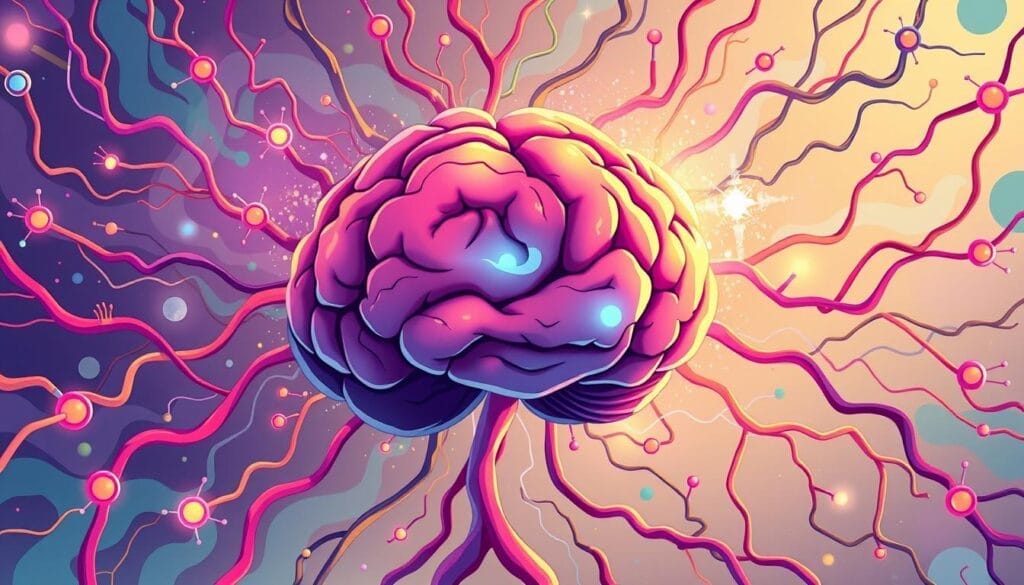
How Does Neuroplasticity Support Brain Injury Recovery?
Now let’s get into the details: How does neuroplasticity in brain injury recovery really help people heal?
What triggers the brain to adapt and form new connections?
The brain responds to both internal and external stimulation. This includes:
- Therapies like physical and occupational therapy
- Stimulation through music, games, or light
- Repetition through daily exercises
With consistent input, the brain builds stronger neural pathways, leading to better cognitive recovery.
How long does it take for the brain to show plastic changes?
It varies from person to person, but early recovery is often the fastest.
- A Johns Hopkins study showed that neuroplasticity spikes in the first 90 days after a stroke.
- Some people improve for months or even years.
So while quick gains are possible, neurological recovery is often a long-term process.
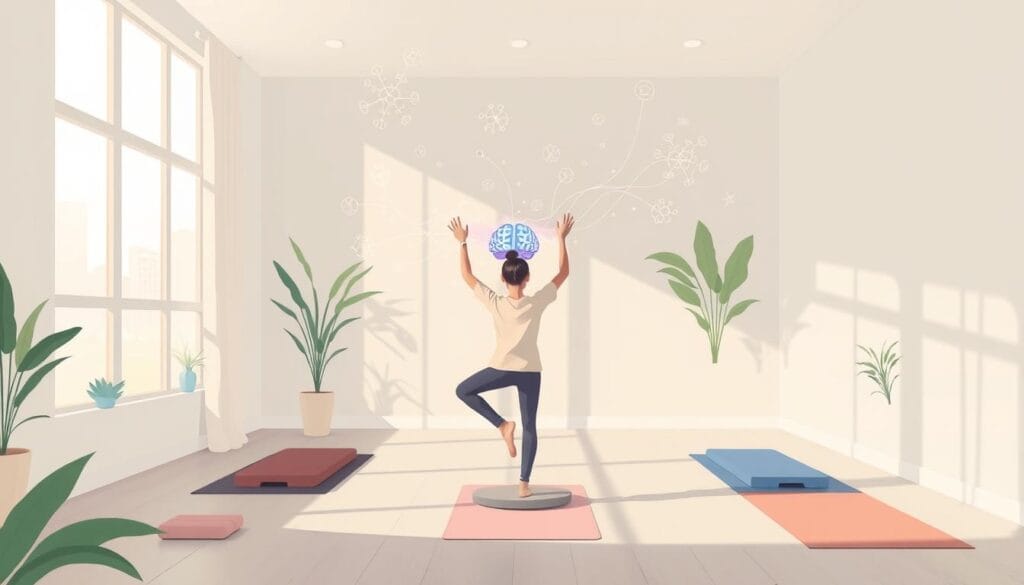
The field of neuroplasticity-based therapies is growing. It offers new hope for those facing brain challenges. These innovative methods are changing how we treat brain injuries. They help people regain their physical, cognitive, and emotional health.
Role of the Environment in Neuroplasticity
The environment is key in helping the brain change and heal. A good environment can make the brain more adaptable and strong. This is because it offers new experiences and challenges.
Importance of a Supportive Environment
Studies found that 62% of animals in a rich environment learn better. These places help the brain grow and work better. They are great for helping people with brain problems like stroke and Alzheimer's.
Engaging Activities That Promote Recovery
Doing puzzles and learning new things keeps the brain active. Mindfulness and exercise also help. These stimulating activities help the brain change and grow stronger.
What Therapies Boost Neuroplasticity After Brain Injury?
Let’s talk about what really helps build neuroplasticity in brain injury recovery.
How does physical therapy promote rewiring of the brain?
Motor relearning is one of the strongest ways to support brain recovery.
- Constraint-induced movement therapy (CIMT): Forces the use of a weaker limb by restricting the stronger one.
- Balance and coordination training: Helps retrain motor control.
- Gait training: Helps with walking.
Repeated practice tells the brain: "This is important. Keep these circuits active."
Can cognitive therapy help improve memory and thinking?
Yes, and it’s essential.
Cognitive rehab helps patients think clearly, recall facts, and solve problems. Tools include:
- Apps for memory games
- Speech therapy
- Puzzles and therapist-led activities
Every task builds brain strength like lifting weights builds muscles.
Do medications and supplements improve neuroplasticity?
Emerging research shows promise, though it's still evolving.
- SSRIs (like fluoxetine) may support brain healing.
- Nootropics may enhance alertness.
- Supplements like BDNF boosters (brain-derived neurotrophic factor) aid recovery.
But all medications should be guided by a doctor.
How do brain scans prove changes in brain structure post-injury?
Brain imaging now lets doctors see functional brain changes.
- fMRI scans show increased activity in undamaged brain parts after therapy.
- PET scans highlight energy use in areas forming new circuits.
Real data: One study found 30% more blood flow in motor cortex areas after 4 weeks of therapy.

Case Studies in Neuroplasticity
Many case studies and clinical trials show the power of neuroplasticity in recovery. These stories show how strong the human brain is. They prove that people can get better, even with big injuries or tough conditions.
Success Stories of Recovery Through Neuroplasticity
A 20-year-old soccer player had vertigo, headaches, and nausea from head injuries. She tried translingual neurostimulation (TLNS) for 14 weeks with rehab. She got better at balance and walking.
EEG tests showed her brain was adapting well. This was a big win for her brain's recovery.
A 28-year-old athlete got hurt badly and had trouble after. He got better with therapy and special brain help. He even went back to sports.
Lessons Learned from Clinical Trials
Clinical trials have taught us a lot about recovery. A study on brain injuries showed TLNS and therapy helped a lot. Patients got better at walking and thinking.
EEG tests showed their brains were working better. This shows how the brain can change and heal, even after big injuries.
These studies show the value of custom treatment plans. They show hope for recovery, even when it seems impossible. They also encourage more research into new ways to help the brain heal.
What Are the Best Daily Practices to Support Neuroplasticity?
Recovery doesn’t stop after therapy. What you do daily matters just as much.
Can lifestyle changes enhance brain recovery?
Yes, your lifestyle is part of your healing plan.
- Eat Omega-3 rich foods like salmon, walnuts
- Sleep 7–9 hours daily for memory storage
- Mindfulness lowers stress and supports new learning
- Aerobic exercise increases BDNF levels
Does repetition really help the brain learn again?
Yes, repetition is the foundation of brain recovery.
- The brain learns from repeated use.
- According to Hebbian learning, "Neurons that fire together wire together."
How important is consistency in recovery efforts?
You don’t need to be perfect. But you must be consistent.
| Recovery Style | Brain Response |
|---|---|
| Inconsistent therapy | Slow or no improvement |
| Consistent repetition | Better brain healing |
Patients who follow daily rehab routines form stronger synaptic reorganization patterns.
What Are the Challenges and Misconceptions Around Neuroplasticity?
People often think the brain can "magically" heal. The truth is more nuanced.
Common Obstacles in the Recovery Process
People recovering from traumatic brain injuries (TBIs) face many hurdles. Dustin Grooms' research at the Ohio Musculoskeletal and Neurological Institute shows the brain changes a lot after injuries. The injury's severity, any pre-existing conditions, and age can affect recovery.
Is there a limit to how much the brain can recover?
Yes, but the limit is not always clear.
- Older patients may experience slower gains.
- Chronic damage takes longer to improve.
Still, with the right therapy, brain regeneration is possible even after years.
What are the common myths about brain healing?
| Myth | Fact |
|---|---|
| "You can fully regrow your brain." | Not true. The brain doesn’t regrow dead cells, but neuroplasticity in brain injury recovery allows other parts to take over lost functions. |
| "Only young brains can change." | False. While younger brains adapt faster, older adults also experience neurological recovery through consistent therapy. |
| "Rest is all you need after a brain injury." | Misleading. Rest is important early on, but brain injury rehabilitation with active effort is crucial for forming new neural pathways. |
| "Once a brain area is damaged, it's gone forever." | Outdated view. With brain plasticity therapy, other regions can learn to perform lost tasks, especially with repetition and stimulation. |
| "Medication can fix everything." | Incorrect. Medication can help but must be paired with cognitive recovery, therapy, and activity for true progress. |
| "You should avoid challenging tasks after brain injury." | Wrong. Challenging the brain through new tasks promotes synaptic reorganization and helps the brain form fresh connections. |
| "Neuroplasticity only affects movement, not thinking or memory." | Incorrect. It also supports cognitive recovery, emotional balance, and speech through changes in various brain circuits. |
| "Improvement stops after 6 months." | Research shows that progress can continue for years. The stroke recovery process often extends beyond one year, especially with continued effort. |
| "Everyone recovers at the same speed." | Not true. Neuroplasticity in brain injury recovery is unique for each person, depending on age, injury type, therapy intensity, and support system. |
| "Brain plasticity only works if you go to rehab centers." | False. While clinics help, at-home exercises and lifestyle changes also strongly support brain healing after injury when guided by a professional. |
| "You need expensive tools for neuroplastic recovery." | Incorrect. Simple, consistent activities like puzzles, walking, and speech exercises often have more impact than fancy machines. |
| "Plasticity only helps after stroke, not trauma." | Wrong. Whether it's stroke, accident, or infection, the brain uses the same adaptive process—how the brain rewires itself—to heal and rebuild. |
| "Old dogs can’t learn new tricks — older adults can’t recover." | Partially false. Age slows down change, but doesn't stop it. Even elderly patients show significant gains with effort and structured therapy. |
| "Once therapy ends, recovery ends too." | Not true. Daily habits, mental stimulation, and physical activity continue the benefits long after formal rehabilitation after stroke ends. |
Future Directions in Neuroplasticity Research
The future of neuroplasticity research is full of hope. New neurotechnology is being developed. Artificial intelligence is being used to make therapies better. Gene therapies are also being explored to help repair the brain.
Emerging Trends and Technologies
Personalized therapies are becoming key. They focus on each person's brain and genes. This mix of new tech and old rehab methods could lead to better treatments.
Researchers hope to unlock neuroplasticity's full power. This could lead to new ways to treat brain and mental health issues. It could also help people stay sharp and focused.
The Promise of Personalized Therapies
Personalized brain training and rehab are very promising. They use each person's brain and genes to create the best plan. This way, treatments can be more effective and targeted.
This approach aims to help those with neurological conditions. It could lead to better results and a brighter future for many.
FAQ
What is neuroplasticity and why is it important?
Neuroplasticity is the brain's amazing ability to change itself. It helps the brain recover from injuries and addiction. This is because the brain can make new paths and strengthen old ones based on what we learn.
What are the different types of neuroplasticity?
There are two main types. Functional neuroplasticity is about changing how the brain works. Structural neuroplasticity is about changing the brain's physical structure.
How does the brain adapt to injury through neuroplasticity?
The brain adapts by making new paths or making old ones stronger. It follows the idea that "use it or lose it" and "use it and improve it." This means connections get stronger with use and weaker without it.
What therapeutic approaches can enhance neuroplasticity in recovery?
Therapies that help include physical therapy, like CIMT. Cognitive therapies like CBT and DBT also help. Even virtual reality can be used.
How does the environment influence neuroplasticity and recovery?
A good environment helps the brain heal. Activities like learning new things and socializing are key. A rich environment challenges the brain to adapt.
What role does nutrition play in supporting neuroplasticity?
Good food is crucial for brain health. Foods with omega-3s, antioxidants, and vitamins support the brain. They help protect cells and improve thinking.
What are some of the challenges in the recovery process through neuroplasticity?
Challenges include how people respond differently to treatments. There can be plateaus and age affects recovery. But, with persistence and the right approach, progress can be made.
What are the future directions in neuroplasticity research?
Future research includes brain-computer interfaces and AI in therapy. Gene therapies are also being explored. Personalized treatments are becoming more common, focusing on individual needs.
The Impact of Hydration on Neurological Health
What if the cause of your brain fog isn't stress or overwork but something as simple as not drinking enough water?
Most people don’t realize this, but your brain is incredibly sensitive to hydration levels. That glass of water you skipped might be the reason you’re forgetting names, headache, feeling anxious, or unable to focus.
The impact of hydration on neurological health is deeper than just keeping your brain refreshed. Even a little dehydration can affect your mood and thinking. Water plays a direct role in how our neurons communicate, how we think, how we feel, and even how we age. Neglecting hydration doesn’t just make you tired, it may silently speed up cognitive decline.
In this blog, we will break down the science behind hydration and brain health. We’ll explore how even mild dehydration can mess with memory, mood, and mental performance and how staying hydrated could help protect your brain from serious conditions like Alzheimer’s and migraines.
Understanding Hydration and Its Importance
Drinking enough water is key for keeping our bodies balanced. It helps our body work right. We need to drink the right amount of water to stay healthy.
Definition of Hydration
Hydration means keeping the right amount of water in our bodies. It's about drinking enough water and eating foods with water. We lose water through sweat, pee, and breathing.
Recommended Daily Water Intake
How much water we should drink changes with age, sex, and how active we are. The Food and Nutrition Board set guidelines for water intake in 2004. For adults, drinking about 8 cups (2 liters) a day is a good rule.
Signs of Dehydration
Even a little dehydration can hurt how we feel and think. Signs include:
- Thirst
- Dry mouth
- Fatigue
- Dizziness
- Headaches
- Dark yellow urine
- Muscle cramps
More than 2% body weight loss from dehydration makes us tired and less focused. This shows why keeping our fluid balance is so important.
The Brain and Water: Why Your Brain Runs on Water?
The human brain is amazing, made up of about 75% water. This shows how important brain hydration is for thinking and brain health. Water helps keep nerves working well by protecting them with a special layer.
Composition of the Brain
The brain's makeup and shape depend on how hydrated it is. Not drinking enough water can shrink the brain. Studies show a 0.55% decrease in brain volume after just 16 hours of water restriction.
But drinking water again can make the brain bigger. It can grow by 0.72% compared to baseline.
Role of Water in Cognitive Function
- Drinking enough water is key for good memory, focus, and concentration.
- Not drinking enough water can hurt how well we think. It can cause ventricular expansion and a 1.63% decrease in brain tissue fluid after just 12 hours without water.
- It's very important for kids' brain growth and for keeping older adults' brains sharp. As we get older, we might not feel as thirsty.
Knowing how the brain and water are connected helps us understand the impact of hydration on neurological health.
How Dehydration Affects Brain Function
Even a 1–3% drop in hydration can mess with how you think.
- Brain fog and slowed thinking become noticeable even before you feel thirsty.
- Headaches often come from the brain pulling away from the skull due to fluid loss.
- Memory and focus suffer because nerve signals slow down.
Study: According to the Journal of the American College of Nutrition (2013), just 1–2% dehydration causes measurable cognitive decline in adults.
Effects of Dehydration on Cognitive Performance
What if your ability to focus at work or school had more to do with water than willpower? Let’s look at what the data says.
Memory, Focus & Decision-Making
Hydration improves how quickly your brain reacts and processes decisions.
- A 2021 systematic review in Nutrients shows a strong link between hydration and executive brain function.
- Brain scans show more activity in the prefrontal cortex when subjects are properly hydrated.
- Decision-making speed improves by up to 14% with adequate water intake.
Mood and Mental Health Connection
Water isn’t just physical, it’s emotional too.
- Dehydration can make you irritable, anxious, and even mimic symptoms of depression.
- The European Journal of Clinical Nutrition found mild dehydration (1.5%) negatively affects mood in both adults and teens.
- Mood swings and low energy often disappear within 20 minutes of drinking water.
The impact of hydration on neurological health includes emotional stability, you might just be thirsty, not moody.
Short-term Consequences
When we don't drink enough water, our brain's skills can go down. This includes memory, how well we can work with information, and how we see and move things. Losing just 2% of our body weight from not drinking enough can make these problems worse.
People who don't drink enough might find it hard to remember things, do math, and stay focused. They might also feel really tired and have trouble concentrating.
Long-term Implications
Dehydration over a long time can really harm our brain. It can make brain cells smaller and weaker. This is something that happens to many older people.
This can weaken the protection around our nerves. Over time, this can cause nerve damage. If we don't drink enough water, the impact of hydration on neurological health can even lead to serious problems like delirium, coma, and death.
It's very important to drink enough water to keep our brain working well. Drinking water can help fix the problems dehydration causes. So, it's key to drink water all day long.

The Link Between Hydration and Memory
Drinking enough water is key for keeping your memory sharp. Research shows that even a little dehydration can hurt your memory and brain work. Drinking water and eating foods that help keep you hydrated can boost your memory and brain function.
Impact on Memory Retention
Dehydration can really affect how well you remember things. A study found that dehydrated adults worked their brains harder when doing tasks that need thinking. Another study showed that older women who didn't drink enough water did worse on tasks that need focus and quick thinking.
Hydration Strategies for Better Recall
To keep your memory and brain working well, drink plenty of water. Here are some tips:
- Drink water all day, aiming for 11.5 cups for women and 15.5 cups for men.
- Eat foods that are full of water, like watermelon, cucumbers, and leafy greens.
- Stay away from drinks with sugar or caffeine, as they can make you lose water.
- Check your urine color to see if you're drinking enough water – it should be light yellow to clear.
By focusing on drinking enough water, you help your brain remember things better. This improves your brain's health and how well you think.
Dehydration & Neurological Disorders
What if managing your neurological condition better started with better hydration? It sounds simple, but studies show water plays a big role.
Migraines and Chronic Headaches
Migraines and chronic tension headaches often start with fluid loss.
- When dehydrated, blood vessels in the brain expand, triggering pain.
- Loss of electrolytes affects nerve sensitivity.
- 1 in 3 migraine sufferers reports dehydration as a common trigger.
Hydration for migraines is a clinically proven strategy for reducing headache frequency.
Alzheimer’s Disease & Cognitive Decline
The glymphatic system is your brain’s clean-up crew. It depends on water.
- Water helps flush out amyloid plaques through the glymphatic system.
- Mild dehydration slows this clearance, allowing harmful buildup.
- Harvard Health (2020) reports early dehydration speeds up cognitive decline in high-risk groups.
Glymphatic system hydration may delay or reduce signs of dementia and Alzheimer's.
Multiple Sclerosis and Parkinson’s
In conditions like MS and Parkinson’s, symptoms worsen with poor hydration.
- Neurological fatigue increases when water levels drop.
- Poor fluid balance worsens cognitive dysfunction.
- Medications often lead to fluid loss as a side effect.
The impact of hydration on neurological health is vital when managing water intake helps patients better cope with brain disorders.
Drinking enough water is key for brain health. It helps with conditions like Alzheimer's and Parkinson's. Drinking water can keep the brain healthy and slow down cognitive decline.
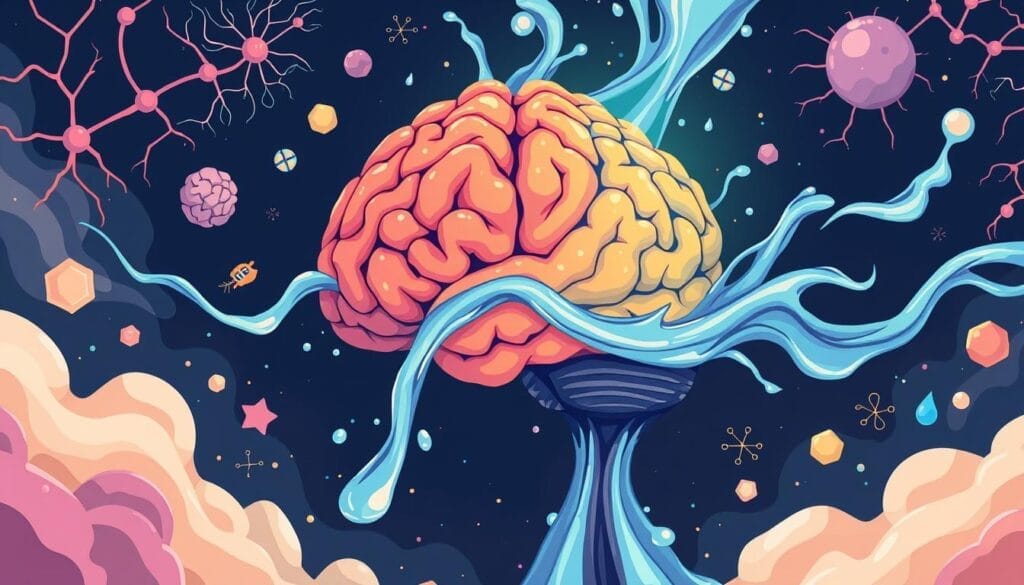
By focusing on hydration, we can support our brain health. It's part of a good healthcare plan. It helps reduce risks from neurodegenerative diseases.
Hydration in Different Age Groups
Keeping the right amount of water is key for brain health. But, each age group has its own needs. It's important to know how much water kids and older adults should drink.
Hydration Needs in Children
Children need enough water for growing and learning. Not drinking enough can hurt their brain and make it hard to focus. It can even slow down their growth.
How much water kids need depends on their age, how active they are, and where they live. It's good to have them drink water all day. Also, give them water-rich foods like fruits and veggies.
Hydration for the Elderly
Older people are more likely to get dehydrated. This is because they might not feel thirsty as much. Their kidneys also change with age, and some health issues can make it harder to stay hydrated.
Research shows that many older adults don't drink enough water. This can lead to serious problems like brain decline and even death. It's very important for older adults to drink enough water to stay healthy.
It's vital to make sure each age group gets the right amount of water. This helps keep their brains healthy from childhood to old age.
Signs You’re Not Drinking Enough for Brain Health
Sometimes we mistake the early signs of dehydration for anxiety or stress. But the brain knows.
Early Symptoms of Dehydration Often Mistaken as “Stress”
If you’re feeling off, these may be dehydration signs:
- Poor focus
- Low energy
- Lightheadedness
- Irritability or sadness
These symptoms mirror early signs of mental fatigue dehydration.
Brain Hydration Checklist
Use this quick checklist to track if your brain is hydrated:
| Symptom | Possible Link to Dehydration |
|---|---|
| Headaches | Likely |
| Trouble focusing | Very Likely |
| Forgetting things | Common |
| Feeling low or anxious | Possible |
| Dry mouth or lips | Definite |
| No thirst, but tired | Hidden dehydration |
Signs of dehydration in the elderly brain or even young adults are easy to miss—check often.
How Much Water Does Your Brain Need? Science-Based Guidelines
The answer depends on age, gender, and activity. But most people don’t drink enough.
Age, Gender & Activity-Based Needs
| Group | Daily Water Intake (Liters) |
| Adult Men | 3.7 L (13 cups) |
| Adult Women | 2.7 L (9 cups) |
| Children (9-13 yrs) | 2.1-2.4 L |
| Elderly Adults | 2.5 L (due to slower thirst) |
How Neurological Patients Should Adjust Fluid Intake
Neurological patients must adjust water intake carefully.
- Medications can cause water loss (e.g., diuretics).
- Mobility issues reduce fluid access.
- Swallowing difficulties may require infusions or thickened fluids.
One line takeaway: Hydration is part of a neuroprotective lifestyle, especially for seniors and chronically ill patients.
Best Practices for Staying Hydrated
Drinking enough water is key for good health, including brain function. Doctors say we should drink at least eight 8-ounce glasses of water a day. This helps our brains work well and keeps our mood stable. But, how much water we need can change based on our age, how active we are, and where we live.
Tips for Daily Hydration
- Carry a reusable water bottle and sip on it all day.
- Set reminders to drink water, especially when you're active or it's hot outside.
- Drink less of things like alcohol and coffee, as they can dry you out.
- Eat foods with lots of water, like watermelon, cucumbers, and oranges, to stay hydrated.
Foods High in Water Content
- Watermelon (92% water content)
- Cucumbers (96% water content)
- Oranges (87% water content)
- Tomatoes (94% water content)
- Broccoli (91% water content)
Eating these foods can help you drink enough water each day. They support your brain's health. Remember, staying hydrated is vital for your brain's well-being.
Morning to Night: Creating a Hydration Routine
- 6:30 am: 1 glass of room-temp water (restarts brain function)
- 10 am: Herbal tea or fruit-infused water
- 1 pm: 1 full glass before lunch
- 3 pm: Coconut water or electrolyte water
- 6 pm: Small cup with light snack
- 9 pm: Small sip if not on fluid restriction
Tips for seniors:
- Use alarms or hydration apps.
- Keep water within reach at all times.
Building a routine supports long-term hydration brain performance.

The Role of Electrolytes in Hydration
Electrolytes, like sodium and potassium, are key for staying hydrated and keeping our nerves working right. They help our nerves send signals by carrying electrical charges.
Importance of Sodium and Potassium
Sodium and potassium help keep the right amount of fluid in our bodies. Sodium keeps fluid inside and outside cells. Potassium is important for muscle work, like the heart.
Balancing Electrolytes for Neurological Health
- Having the right electrolyte balance is key for good neural performance. If electrolytes are off, we might feel confused, weak, or even have seizures.
- Keeping electrolytes balanced helps our nerves talk to each other smoothly. This is how our brain and body communicate.
- When we're dehydrated, our electrolytes can get out of whack. This can hurt our nerves. Drinking enough water and eating right is important for our brain health.
Knowing how important electrolytes are helps us stay healthy. We can keep our electrolyte balance right by drinking enough water and eating well. This supports our neural performance.
Supplements & Hydration Synergy
Some vitamins only work when your body is hydrated.
- Magnesium: Helps regulate nerve signals; needs water to absorb.
- B Vitamins: Support brain energy; water-soluble.
- Omega-3s: Reduce neuroinflammation and water intake helps them reach brain tissues.
One line takeaway: Stay hydrated so your brain supplements don’t go to waste.
Debunking Common Hydration Myths About the Brain
Let’s break down some common myths about brain hydration in a simple table format.
| Myth | Truth |
| Only athletes need to worry about dehydration | False. Everyone needs hydration for brain function, even desk workers and students. |
| Thirst is the only signal your body gives | False. The brain misreads thirst—especially in older adults. You can be dehydrated without feeling thirsty. |
| Coffee and tea dehydrate you | Outdated. Caffeine is mildly diuretic, but these drinks still contribute to hydration. |
| Clear urine always means you're hydrated | Misleading. Clear urine can result from overhydration or poor kidney function. |
| Drinking lots of water at once rehydrates quickly | Risky. Overloading water too fast can cause electrolyte imbalance, sip throughout the day instead. |
| If you’re not sweating, you’re not losing fluids | False. You lose fluids through breathing, digestion, and dry environments too. |
Hydration isn’t about waiting until you're thirsty, it’s about keeping your brain functioning at its best, every day.
Monitoring Hydration Levels
Keeping your body hydrated is key for your brain's health. But how do you know if you're drinking enough water? There are many ways to check if you're drinking enough fluids.
Tools and Techniques for Assessment
One easy way to check if you're hydrated is by looking at your urine. Use a urine color chart to see if it's light yellow (good) or dark yellow (you need more water). You can also try bioelectrical impedance analysis, which sends electrical signals to measure your body's water.
Blood tests can give you a detailed look at your hydration assessment and fluid balance. They check your electrolyte levels, like sodium and potassium. These are important for keeping your body hydrated.
Hydration Apps and Technology
Thanks to tech, keeping track of your water intake is easy. Many apps help you monitor your water, remind you to drink, and offer tips based on your activity and weather. Smart water bottles and fitness trackers also track your hydration assessment and fluid balance all day. They help keep your brain and nervous system healthy.
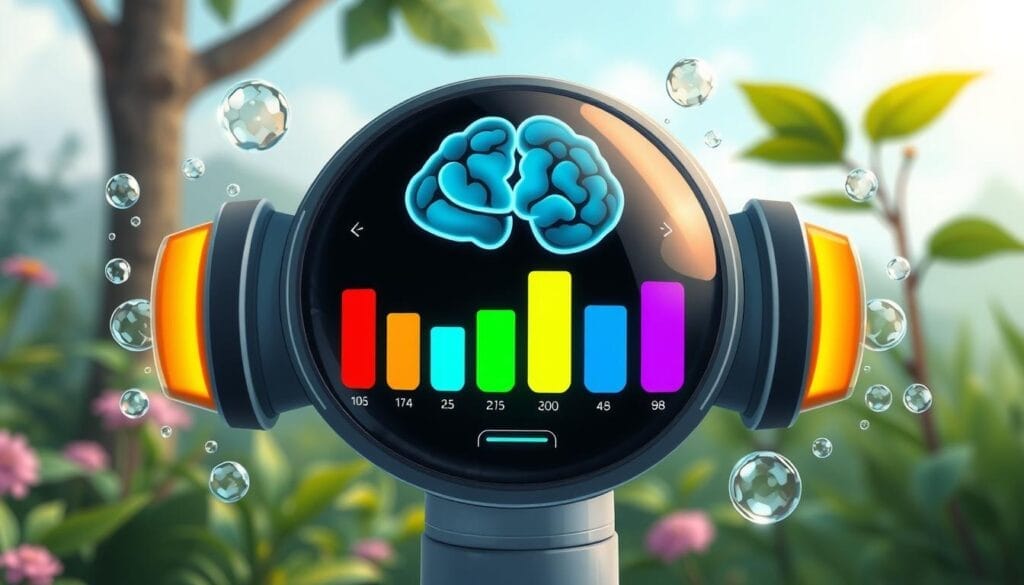
Using these tools and apps daily can help you manage your hydration. This way, your brain and nervous system will work their best.
Dr. Chugh's Advice: Don’t Wait Until You’re Thirsty
As a neurologist, I’ve seen patients with chronic cluster headaches, memory complaints, even early dementia, all linked to dehydration.
Hydration isn’t a side note. It’s a daily commitment to brain health. If you're experiencing brain fog, low mood, or forgetfulness, don’t brush it off.
Book a consultation today to discuss how hydration fits into your brain health plan. Don’t wait until symptoms get worse.
FAQ
What is the impact of hydration on neurological health?
Drinking enough water is key for your brain to work well. It helps with thinking, mood, and brain health. Even a little dehydration can hurt memory, focus, and concentration.
What is the recommended daily water intake for maintaining neurological health?
You should drink at least eight 8-ounce glasses of water a day. But, your needs might change based on your age, how active you are, and where you live.
What are the signs of dehydration?
Signs of dehydration include feeling thirsty, dry mouth, tiredness, dizziness, headaches, dark yellow urine, and muscle cramps. Even a small amount of dehydration can affect how well you think and move.
How does water composition affect the brain?
The brain is about 75% water. This shows how important water is for thinking clearly. Water helps keep the brain's protective layer working right.
What are the short-term and long-term effects of dehydration on neurological health?
Dehydration can make it hard to remember things, focus, and think clearly right away. Over time, it can also damage the protective layers around nerves, leading to nerve damage.
How does hydration influence mood and mental health?
Even a small amount of dehydration can make you feel more anxious and depressed. It can also change how blood flows to parts of the brain that control mood.
What is the relationship between hydration and memory performance?
Drinking enough water is key for remembering things and recalling them. Studies show that even a little dehydration can hurt memory. Staying hydrated helps keep your memory sharp and your brain working well.
How can hydration affect neurological disorders?
Drinking enough water can help keep your brain healthy and prevent cognitive decline. It's a good way to manage conditions like Alzheimer's and Parkinson's disease.
How do hydration needs differ across age groups?
Kids need enough water for growth and brain development. Older adults are more likely to get dehydrated because they don't feel thirsty as much and their kidneys change.
What are the best practices for staying hydrated?
To stay hydrated, drink at least eight 8-ounce glasses of water a day. Eat foods that help you stay hydrated, avoid drinks that make you lose water, and drink water often when you're active, especially in hot weather.
What is the role of electrolytes in hydration and neurological health?
Electrolytes like sodium and potassium are important for staying hydrated and for your brain to work right. They help nerves send signals and keep the electrical impulses needed for communication.
How can I monitor my hydration levels?
You can check if you're hydrated with urine color charts, bioelectrical impedance analysis, and blood tests. There are also apps and smart water bottles that help you keep track of how much water you drink and remind you to drink more.




